
Original text

Why All Small Business Owners Need a Personal Financial Statement
Running a small business is exhilarating, demanding and often a blur of financial uncertainty. While most entrepreneurs focus on their business’s bottom line and keep their financial statements current, they often neglect to document their personal finances. That’s wrong. Every small business owner needs to create a personal financial statement (PFS), which serves as a personal balance sheet, documenting your assets, liabilities and net worth.
When do you need a personal financial statement?
Many small business owners may need a loan or other outside financing as they grow their companies. That usually requires providing a lot of documentation to the lender. But lenders don’t only want to see your business finances. Most require a personal financial statement as well.
If you decide to pledge personal assets as collateral, lenders definitely want to know the details about those assets. Financial institutions may wish to conduct a fiscal health evaluation of your personal finances so they can assess how well you manage money. For instance, if you have few assets and a lot of outstanding debt, it can indicate you would have trouble repaying a loan.
Are you thinking of buying an existing business or a franchise? The business owner, broker and/or franchisor will ask for a PFS as evidence that you’re financially able to purchase the business or franchise.
If you plan to rent a commercial office, retail space, or other types of business space, the landlord will likely request a personal financial statement before approving your lease.
As you can see, there are numerous reasons you need a PFS. It’s smart to prepare yours now (and keep it updated) so it will be ready when needed.
Personal financial statements are financial snapshots offering numerous benefits.
Beyond simply tracking your assets and liabilities, a PFS offers several vital benefits for entrepreneurs. Creating your PFS is like getting a checkup, except the result is a fiscal health evaluation rather than a physical one.
Some of the benefits of preparing a personal financial statement (sometimes called a personal financial summary):
- Securing funding: As we already noted, when seeking loans for business expansion, new equipment or company vehicles, lenders rely on your PFS to assess your creditworthiness and ability to repay. A strong PFS significantly increases your chances of securing favorable loan terms and interest rates.
- Understanding your net worth: Your PFS provides a clear picture of your overall financial standing, including your assets (cash, investments, property) and liabilities (debt, loans, mortgages). Seeing a comprehensive view helps you make informed decisions about investments, savings goals and risk management.
- Making prudent financial decisions: With a clear understanding of your income, expenses and debt obligations, you can make informed choices about spending, investments and financial planning. Your PFS empowers you to avoid impulsive decisions and build a solid financial foundation.
- Monitoring progress and adapting: Regularly reviewing your PFS allows you to track your progress toward your financial goals and identify areas for improvement. This ongoing review process enables you to pivot, adapt, and adjust your strategies as your business and personal circumstances evolve.
What's included in a personal financial statement?
A typical PFS is divided into two main sections—assets and liabilities.
List of assets
- Current Assets include cash, checking and savings accounts, certificates of deposit, short-term investments and accounts receivable.
- Investment Assets include stocks, bonds, mutual funds and retirement accounts (IRAs, 401(k)s).
- Fixed Assets include real estate holdings and personal property, such as jewelry, cars and other items of significant value (art collection, first editions of books, etc.)
List of liabilities
- Current Liabilities include credit card debt, outstanding bills and short-term loans.
- Long-term Liabilities include mortgages, car loans, student loans and personal loans.
Do not include business assets or liabilities in your personal financial statement.
Creating your financial snapshot
You don’t need to be a financial wizard to create a PFS. Here’s how:
- Gather your documents: Collect bank statements, investment account statements, loan documents and receipts for major purchases.
- Choose a format: You can use an online template, spreadsheet or pen and paper. Choose the best format for you and ensure consistency for future updates.
- List your assets: Identify and value all your assets using current market values for investments and real estate.
- List your liabilities: Include all your debts, noting the remaining balances and interest rates.
- Calculate your net worth: Subtract your total liabilities from your assets to determine your net worth. While this is part of your overall personal balance sheet, you should keep this calculation as a separate net worth statement.
- Review and update regularly: Your PFS is not static. Update it regularly, ideally quarterly, to reflect changes in your financial situation.
When creating your personal financial statement, it’s critical to be honest and accurate. This wealth assessment is for your own benefit to help you (and lenders) make informed decisions. No one is judging you.
A PFS helps you take ownership of your personal finances and equips you with the knowledge and confidence to navigate the challenges and reap the rewards of entrepreneurship. A healthy business rests on a solid personal financial foundation.
If navigating financial statements feels overwhelming, consider consulting with a financial advisor, accountant or SCORE mentor .
National Bankers Association Foundation
The National Bankers Association Foundation’s mission is to eliminate the racial wealth gap by ensuring underserved communities have fair access to transformative financial education, services, and resources. To accomplish this, we support the work of Minority Depository Institutions (MDIs) through our four strategic pillars, which include: Financial Education, Entrepreneurship and Small Business, Research and Impact, and Collaboration and Capacity Building.
Copyright © 2024 SCORE Association, SCORE.org
Funded, in part, through a Cooperative Agreement with the U.S. Small Business Administration. All opinions, and/or recommendations expressed herein are those of the author(s) and do not necessarily reflect the views of the SBA.
- Search Search Please fill out this field.
Personal Cash Flow Statement
Personal balance sheet, bringing them together, the bottom line.
- Personal Finance
- Budgeting & Savings
Evaluating Your Personal Financial Statement
Tips to help with budget planning and figuring your net worth
:max_bytes(150000):strip_icc():format(webp)/Office2-EbonyHoward-8b4ada1233ed44aca6ef78c46069435d.jpg)
Many individuals look at their bank and credit card statements and are surprised by how much they've spent. One simple method of accounting for income and expenditures is to keep personal financial statements just like the ones used by corporations. Financial statements provide you with an indication of your financial condition and can help with budget planning. There are two types of personal financial statements: the personal cash flow statement and the personal balance sheet .
Key Takeaways
- You can create your own personal financial statements to help with budget planning and to set goals for increasing your net worth.
- Two types of personal financial statements are the personal cash flow statement and the personal balance sheet.
- The personal cash flow statement measures your cash inflows or money you earn and your cash outflows or money you spend. This determines if you have a positive or negative net cash flow.
- A personal balance sheet summarizes your assets and liabilities to calculate your net worth.
A personal cash flow statement measures your cash inflows and outflows to show you your net cash flow for a specific period. Cash inflows generally include:
- Interest from savings accounts
- Dividends from investments
- Capital gains from the sale of financial securities like stocks and bonds
Cash inflow can also include money received from the sale of assets like houses or cars. Your cash inflow essentially consists of anything that brings in money.
Cash outflow represents all your expenses regardless of size. Cash outflows include these types of costs:
- Rent or mortgage payments
- Utility bills
- Entertainment, such as books, movie tickets, and restaurant meals
The purpose of determining your cash inflows and outflows is to find your net cash flow. Your net cash flow is simply the result of subtracting your outflow from your inflow. A positive net cash flow means that you earned more than you spent and you have some money left over from that period. A negative net cash flow shows that you spent more money than you brought in.
A balance sheet is another type of personal financial statement. A personal balance sheet provides an overall snapshot of your wealth at a specific period in time. It's a summary of your assets or what you own and your liabilities or what you owe. It results in your net worth : your assets minus liabilities.
Your Assets
Assets can be classified into three categories:
- Liquid Assets: These are things you own that can easily be sold or turned into cash without losing value. They include checking accounts, money market accounts, savings accounts, and cash. Some people include certificates of deposit (CDs) in this category but the problem with CDs is that most of them charge an early withdrawal fee, causing your investment to lose a little value.
- Large Assets: Large assets include houses, cars, boats, artwork, and furniture. Make sure to use the market value of these items when you're creating a personal balance sheet . You can use recent sales prices of similar items if it's difficult to find a market value.
- Investments: Investments include bonds, stocks, CDs, mutual funds , and real estate. You should record investments at their current market values as well.
Your Liabilities
Liabilities are what you owe. They include current bills, payments still owed on some assets like cars and houses, credit card balances , and other loans.
The "debt avalanche" and the "debt snowball" are two popular methods for paying off liabilities such as credit card debt.
Your Net Worth
Your net worth is the difference between what you own and what you owe. This figure is your measure of wealth because it represents what you own after everything you owe has been paid off. You owe more than you own if you have a negative net worth.
You can increase your net worth by increasing your assets or decreasing your liabilities. You can increase assets by increasing your cash or increasing the value of any asset you own. Just make sure that you don't increase your liabilities along with your assets.
Your assets will increase if you buy a house but your liabilities will also increase if you take out a mortgage on that house. Increasing your net worth through an asset increase will only work if the increase in assets is greater than the increase in liabilities. The same goes for trying to decrease your liabilities. A decrease in what you owe has to be greater than a reduction in assets.
Personal financial statements give you the tools to monitor your spending and increase your net worth. They're not just two separate pieces of information. They work together.
Your net cash flow from the cash flow statement can help you in your quest to increase your net worth. You can apply the money to acquiring assets or paying off liabilities if you have a positive net cash flow in a given period. Applying your net cash flow toward your net worth is a great way to increase assets without increasing liabilities or to decrease liabilities without increasing assets.
What Are Some Examples of Non-Liquid Assets?
Non-liquid assets are those that you can't sell or dispose of quickly if you need cash. Real estate, automobiles, artwork, and jewelry are all non-liquid assets. They can also lose value in the sales process. You might purchase your home for $350,000 and then have to sell it for only $300,000 if you find yourself in an emergency where you have to liquidate assets as quickly as possible to raise cash.
How Much Does the Average American Spend a Year?
The U.S. Bureau of Labor Statistics reported in September 2023 that average annual expenditures per household were $72,967 in 2022. This was up 9% from the year before. Average income before taxes increased only 7.5% during the same timeframe.
How Much Money Should I Have in Savings?
It's been said that you should save six months' worth of living expenses tucked away but the U.S. Securities and Exchange Commission puts a slightly different spin on that. It says you should have six months' worth of income saved. That works out to $30,000 if you earn $60,000 a year.
The SEC also suggests that you might want to consider paying off your high-interest credit card debt to amass some savings rather than invest your money, hoping to earn some. You might find that the amount you're saving on interest is more than a safe investment such as a money market or mutual fund would pay you in a given period.
Approach your finances like a financial advisor during your annual review . If you have a negative cash flow or you want to increase positive net cash flow, the only way to do it is to assess your spending habits and adjust them as necessary. You'll be well on your way to greater financial security if you use your personal financial statements to become more aware of your spending habits and your net worth.
Cornell Law School Legal Information Institute. " Liquid Asset ."
U.S. Bureau of Labor Statistics. " Consumer Expenditures—2022 ."
U.S. Securities and Exchange Commission. " Financial Navigating in the Current Economy: Ten Things to Consider Before You Make Investing Decisions ."
:max_bytes(150000):strip_icc():format(webp)/0-banksavings-951dc516fac84b50a6b6032cceacbcc3.jpg)
- Terms of Service
- Editorial Policy
- Privacy Policy
- Your Privacy Choices
- Search Search Please fill out this field.
- Financial Planning
What Is a Personal Financial Statement?
:max_bytes(150000):strip_icc():format(webp)/IMG_0031-a6116af31d5a4783a969390cd325367c.jpg)
- Definition and Examples
How Does a Personal Financial Statement Work?
Do i need a personal financial statement.
Xavier Lorenzo / Getty Images
A personal financial statement is a physical snapshot of your assets compared to your liabilities. It gives you a real-time view of your wealth and helps you assess your current financial situation. While it's beneficial for your own financial growth, lenders may ask for a personal financial statement if you’re applying for a loan
Key Takeaways
- A personal financial statement is a document that lists all your assets, liabilities, and resulting net worth.
- Personal financial statements can be used by individuals and businesses.
- A personal financial statement is important because it shows you if you’re building wealth, and can play a critical role in helping you get approved for loans.
- The most efficient way to keep your personal financial statement up-to-date is to use budgeting software that tracks your net worth for you.
Definition and Examples of a Personal Financial Statement
A personal financial statement is a physical snapshot of your assets compared to your liabilities . It gives you a real-time view of your wealth and helps you assess your current financial situation. While it's beneficial for your own financial growth, lenders may ask for a personal financial statement if you’re applying for a loan
But what are assets and liabilities? Your assets refer to all items you can easily convert to cash, including:
- Bank accounts
- Retirement accounts
- Investment balances
- Real estate
- Personal property with significant value, such as rare art collections, coin collections, antiques, and jewelry
Your liabilities refer to all the debt you owe. They can be:
- Student loans
- Credit card debt
- Car and boat loans
- Loans where you’re the co-signer
- Unpaid taxes
- Medical debt
If your total assets are higher than your liabilities, your personal financial statement reflects a positive net worth . This is a sign that you’re building wealth and signals to lenders that you may be a trustworthy borrower.
If your liabilities are higher than your assets, however, you have a negative net worth. This signals you may be living paycheck to paycheck or spending more than you earn, and you could be seen as a high-risk borrower to lenders.
If you are in a committed partnership or married and share assets, you and your partner can combine assets and liabilities to create a joint personal financial statement.
Suppose you have $200,000 worth of assets. This includes your house, a bank account, and a retirement account. Now let’s say you have $130,000 in liabilities. This includes your mortgage, some student loans , and credit card debt. In this case, your net worth is $70,000.
Here’s an example of how your personal financial statement may look in spreadsheet form:
The Balance
Your personal financial statement will be a lot more complex if you’re creating one for your business. For small business owners, the Small Business Administration (SBA) has a sample personal financial statement you can use as a guide.
Wealth is not defined by the income you accumulate, but by your net worth. A personal financial statement is important because it shows if your net worth is improving or decaying over time. It sheds light on your entire financial picture so you can see if you’re moving closer or farther away from your goals .
For example, suppose your financial goal is to retire early . You’ve officially paid off your debt (minus your mortgage), but you’re not sure how close you are to reaching your retirement goals. You decide to create a personal financial statement to see where you stand.
Below is a guide to how you would fill out your personal financial statement, using the above example.
Step 1: List All Your Assets
Most assets have a clear dollar value (i.e., you can look in your bank account and see what your balance is). But some assets—such as your car, home, or an art collection—may require an appraisal first.
If you’re creating a personal financial statement for a lender, it’s important to be as accurate as possible (and get an appraisal if you’re unsure of the amount). But if it’s just for your own personal records, an educated guess may be fine. This may look like:
- $600,000 in your home
- $150,000 in your 401(k)
- $125,000 in your investment account
- $40,000 in your checking and savings accounts
- $30,000 in your traditional IRA
- $5,000 for your car
Total assets = $950,000
Anything you rent does not count as an asset because you don’t own it. So if you rent a house or lease a car, leave it off your personal financial statement.
Step 2: List All Your Debt
Your debts are your liabilities. In this example, we’ve stated you’ve paid off all your debt except your mortgage, so that’s the only thing listed here.
- $300,000 on your mortgage
Total liabilities = $300,000
If you pay your credit card bill off in full every month, it’s not considered debt, so don’t include it on your personal financial statement.
Step 3: Subtract the Two Numbers To Get Your Net Worth
In this example, when you subtract the assets from your liabilities, you see that your total net worth is $650,000.
Now, suppose you know you need $1.2 million to reach financial freedom and retire early. Your personal financial statement would show that you’re $550,000 away from your goal. You could then update it again next month to track your progress, and make changes to your spending and saving as needed.
Personal financial statements help individuals understand the overall state of their personal or business finances, and calculate their net worth. They can also be used as a tool when applying for credit such as a mortgage, personal loan, or business loan . To get a snapshot of your financial health, it’s a good idea to create a personal financial statement.
Even if you have a positive net worth, it is not guaranteed you will receive a loan you apply for. Credit history and past debts are also taken into consideration by lenders.
The biggest drawback of personal financial statements is that it’s a frozen snapshot of your financial health at any given time. For it to have a positive impact, you have to update it regularly.
The good news is that there are many online tools you can use to automate your personal financial statement. Two popular options include:
- You Need a Budget (YNAB) : This is a personal finance software with strong financial budgeting features that can automatically track your assets and liabilities for you. As you earn income and pay off debt, your net worth updates in real time.
- Personal Capital : This tool for tracking your net worth acts as more of a wealth management tool, praised for helping you track and optimize investments and spot ways to diversify and manage risk. It connects with more than 14,000 financial institutions and provides a moving snapshot of your net worth.
Clearview Credit Union. " What Is a Personal Financial Statement? " Accessed Oct. 28, 2021.
Personal Capital. " Our Mission: We Transform Financial Lives Through Technology and People ." Accessed Oct. 28, 2021.

- Personal Financial Statement

Written by True Tamplin, BSc, CEPF®
Reviewed by subject matter experts.
Updated on November 15, 2023
Get Any Financial Question Answered
Table of contents, what is a personal financial statement.
A personal financial statement is a report or set of documents that summarizes an individual's financial situation at a particular time.
It is often divided into two sections: the balance sheet and the income statement.
The balance sheet provides a breakdown of assets and liabilities, while the income statement summarizes income and expenses.
General information about an individual, such as name and address, may also be included in a personal financial statement.
Individuals can use personal financial statements to monitor their current economic situation.
What Personal Financial Statement Includes
A personal financial statement is typically divided into two sections. These are:
Balance Sheet
The financial statement contains a section known as a balance sheet, which summarizes a person's assets, including cash and investments , and liabilities like debts or loans.
The balance sheet is also used to calculate an individual’s net worth, which is the value of assets minus the amount of liabilities.
Income Statement
The next section, the income statement , details the flow of income and expenses that influences a person's financial situation.
Income statements list all sources of income, such as salaries, bonuses, and dividends .
Expenses such as insurance payments, electricity, or grocery bills are also included.
What Personal Financial Statement Excludes
A personal financial statement does not include the following items:
Company Assets and Liabilities
Company resources and debts are removed from the financial statement unless the individual has direct and personal responsibility.
When someone personally guarantees a loan for their business, the loan is included in their personal financial statement.
Loaned Items
Loaned assets are not owned, so they are not included in personal financial statements.
However, if an individual owns a property and rents it out to others, then the property's value is included in the financial statement list.
Personal Belongings
Furniture and home goods are often not shown as assets on a personal balance sheet since they cannot be easily sold to pay off a loan.
Personal goods with high monetary value, such as jewels and antiques, may be included if their worth can be shown by an evaluation.
Personal Financial Statement Example
Let us look at an example of a personal financial statement using the hypothetical case of Jeffrey.
Below is an example of what Jeffrey’s balance sheet may look like in spreadsheet form.
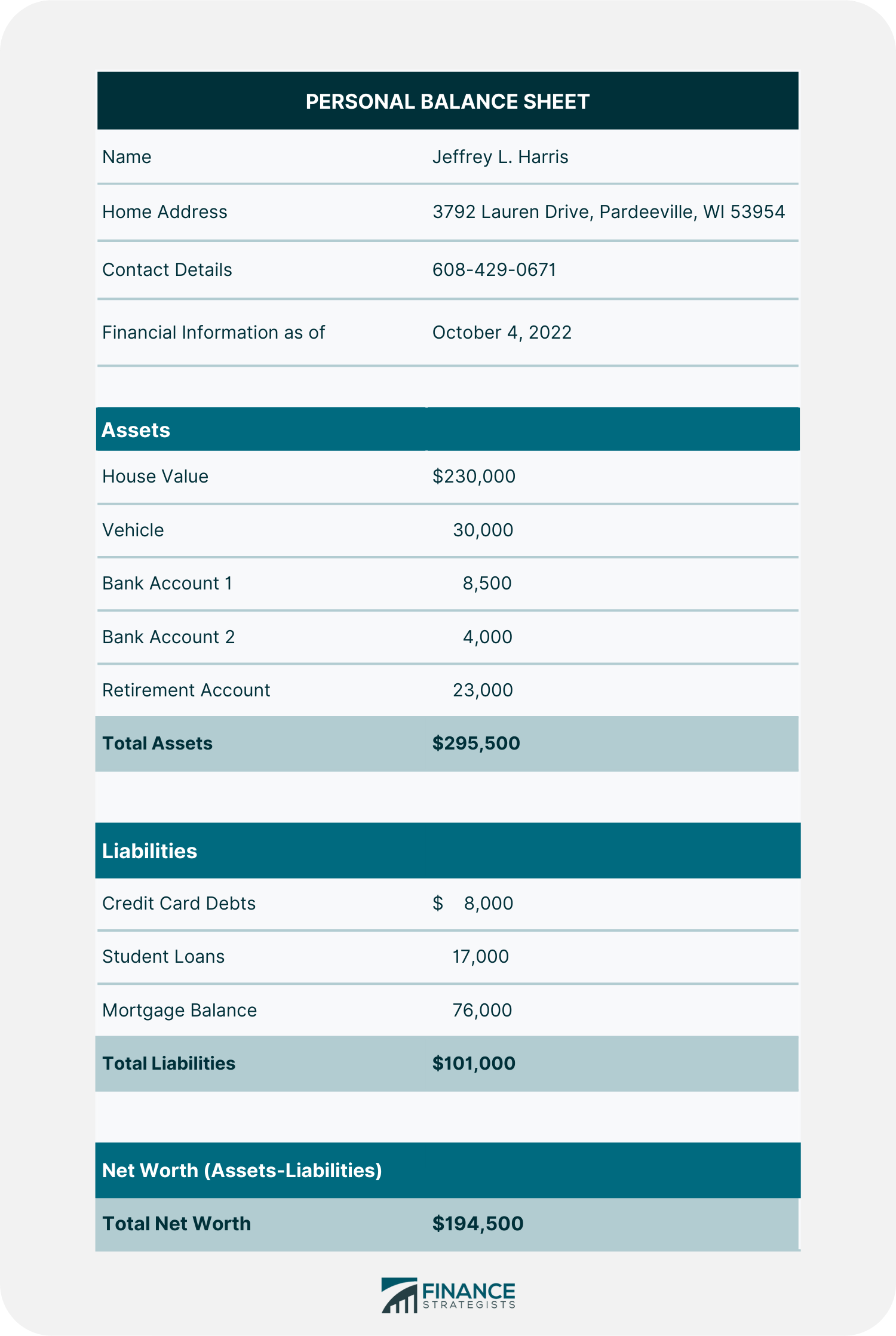
As shown above, Jeffrey has $295,500 worth of assets. This includes the assets like a house, a vehicle, bank accounts, and a retirement account.
Now let us say he has $101,000 in liabilities as well. This includes credit card debts, student loans and mortgages.
With this information, his balance sheet should reflect a net worth of $194,500.
Here is an example of what Jeffrey’s income statement may look like in spreadsheet form:
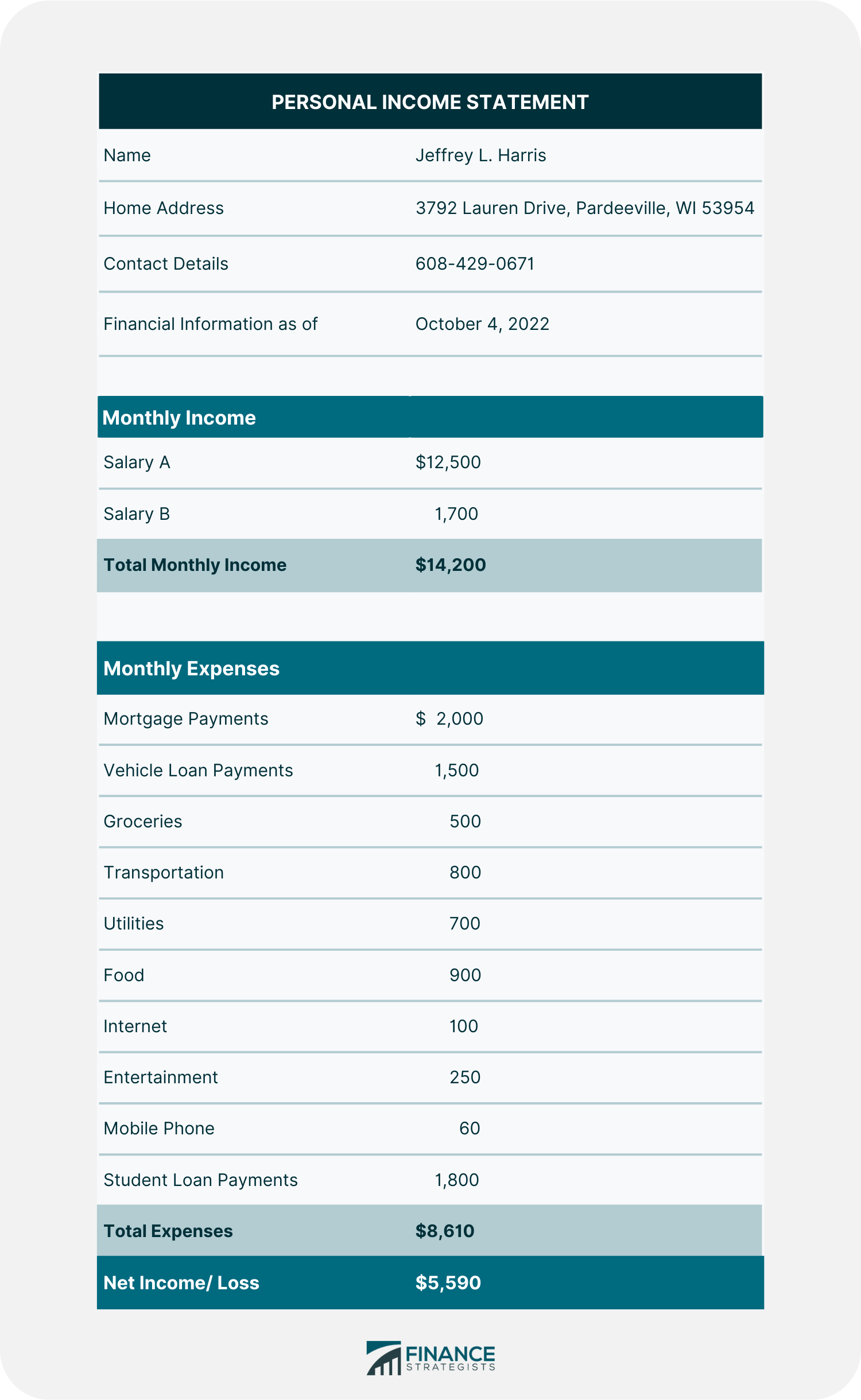
As shown above, Jeffrey receives a total monthly income of $14,200 and spends a total of $8,610 in expenses.
After subtracting expenses from income, Jeffrey has a net income of $5,590.
Taken together, Jeffrey’s balance sheet and income statement provide useful information about his current financial situation.
How to Create a Personal Financial Statement
Let us look at a guide on how to create a personal financial statement.
How to Create a Personal Balance Sheet
- List All Assets
Indicate the dollar value of the assets to be declared. Accuracy is important, particularly when creating a statement for the purpose of borrowing.
Find the total value of all available assets.
- List All Debts
Liabilities come from debts. State the obligations that have to be settled and debts to be paid.
Common items include credit card debts, mortgage debts, and student loans.
Find the total value of all liabilities.
- Determine the Net Worth
Net worth is calculated by deducting total liabilities from total assets.
How to Create a Personal Income Statement
- List all Money Received from Various Sources
Determine the amount of money coming in from various sources. This usually includes regular income received monthly.
- List all Expenses
Make a list of all monthly spending. Start with fixed costs before moving to variable costs.
- Determine Net Profit or Loss
The net profit or loss can be calculated by subtracting the total monthly expenses from the total income or revenue generated in that month.
Importance of a Personal Financial Statement
Here are some reasons why it is important to create a personal financial statement.
Financial Planning
A personal financial statement is an important tool that can be used for financial planning.
It provides a snapshot of an individual's financial situation at a particular point in time, which can be helpful in making future projections and plans.
The statement can also be used to track progress over time and to identify areas where improvements can be made.
Personal financial statements are essential when filing taxes because they summarize income made throughout the year.
They also provide an idea of possible deductions that can be made to lower an individual’s tax rate.
Loan Application
Personal financial statements are often required when applying for credit, such as a loan or mortgage .
Lenders use the information in the statement to assess an individual's ability to repay the debt and to determine the interest rate that will be charged.
In some cases, a personal financial statement may be used in lieu of a credit report when applying for credit.
Final Thoughts
A personal financial statement can be a helpful tool in managing finances and making future plans.
Personal financial statements include balance sheets to monitor assets and liabilities and income statements to track an individual’s income and expenses.
Details on the assets and liabilities related to an individual’s businesses, any rented items and personal belongings are not included in a personal financial statement.
Personal financial statements can be used for a variety of purposes, including financial planning, overviewing an individual's financial situation, and loan applications.
Personal financial statements must be updated on a regular basis to provide an accurate picture of an individual’s current economic situation.
Personal Financial Statement FAQs
What is a personal financial statement.
A personal financial statement is a report or set of documents that summarizes an individual's financial situation at a particular time.
What is included in a personal financial statement?
A personal financial statement includes information on an individual's balance sheet and income statements. The balance sheet provides a summary of assets and liabilities, whereas the income statement summarizes revenue and costs.
What is excluded from a personal financial statement?
Personal financial statements do not include details of a company’s assets and liabilities, loaned items, and personal belongings.
Why is a personal financial statement important?
It is important because it provides a snapshot of an individual's financial situation at a particular point in time. It can help to identify areas where expenses may be excessive or where there is room to make cuts in order to save money. The statement can also be used to track progress toward financial goals.
What does a personal financial statement show?
A personal financial statement shows an individual's assets, liabilities, income, and expenses. It can help to identify areas of financial strength and weakness and to track progress over time.
About the Author
True Tamplin, BSc, CEPF®
True Tamplin is a published author, public speaker, CEO of UpDigital, and founder of Finance Strategists.
True is a Certified Educator in Personal Finance (CEPF®), author of The Handy Financial Ratios Guide , a member of the Society for Advancing Business Editing and Writing, contributes to his financial education site, Finance Strategists, and has spoken to various financial communities such as the CFA Institute, as well as university students like his Alma mater, Biola University , where he received a bachelor of science in business and data analytics.
To learn more about True, visit his personal website or view his author profiles on Amazon , Nasdaq and Forbes .
Related Topics
- Articulation
- Cash Flow Analysis
- Cash Flow Management
- Cash Flow Planning
- Classified Financial Statement
- Components of the Accounting Equation
- Financial Statement Footnotes
- Financial Statement Preparation
- How to Read an Annual Report
- Interim Statements
- Multi-Step Income Statement
- Net Worth Statement
- Profit and Loss Statement (P&L)
- Single-Step Income Statement
- Statement of Changes in Financial Position
- 1040EZ Form
- 183-Day Rule
- 90-Day Letter
- Ad Valorem Tax
- Additional Child Tax Credit
- After-Tax Income
- American Opportunity Tax Credit (AOTC)
- Capital Gains Tax Accountant
- Charitable Tax Deductions
- Child Tax Credit
- Cryptocurrency Tax Accountant
- Do You Need a Tax Accountant?
- Do You Need an Accountant to File Your Taxes?
Ask a Financial Professional Any Question
Search for local tax preparers, find advisor near you, our recommended advisors.

Taylor Kovar, CFP®
WHY WE RECOMMEND:
Fee-Only Financial Advisor Show explanation
Certified financial planner™, 3x investopedia top 100 advisor, author of the 5 money personalities & keynote speaker.
IDEAL CLIENTS:
Business Owners, Executives & Medical Professionals
Strategic Planning, Alternative Investments, Stock Options & Wealth Preservation

Claudia Valladares
Bilingual in english / spanish, founder of wisedollarmom.com, quoted in gobanking rates, yahoo finance & forbes.
Retirees, Immigrants & Sudden Wealth / Inheritance
Retirement Planning, Personal finance, Goals-based Planning & Community Impact
We use cookies to ensure that we give you the best experience on our website. If you continue to use this site we will assume that you are happy with it.
Fact Checked
At Finance Strategists, we partner with financial experts to ensure the accuracy of our financial content.
Our team of reviewers are established professionals with decades of experience in areas of personal finance and hold many advanced degrees and certifications.
They regularly contribute to top tier financial publications, such as The Wall Street Journal, U.S. News & World Report, Reuters, Morning Star, Yahoo Finance, Bloomberg, Marketwatch, Investopedia, TheStreet.com, Motley Fool, CNBC, and many others.
This team of experts helps Finance Strategists maintain the highest level of accuracy and professionalism possible.
Why You Can Trust Finance Strategists
Finance Strategists is a leading financial education organization that connects people with financial professionals, priding itself on providing accurate and reliable financial information to millions of readers each year.
We follow strict ethical journalism practices, which includes presenting unbiased information and citing reliable, attributed resources.
Our goal is to deliver the most understandable and comprehensive explanations of financial topics using simple writing complemented by helpful graphics and animation videos.
Our writing and editorial staff are a team of experts holding advanced financial designations and have written for most major financial media publications. Our work has been directly cited by organizations including Entrepreneur, Business Insider, Investopedia, Forbes, CNBC, and many others.
Our mission is to empower readers with the most factual and reliable financial information possible to help them make informed decisions for their individual needs.
How It Works
Step 1 of 3, ask any financial question.
Ask a question about your financial situation providing as much detail as possible. Your information is kept secure and not shared unless you specify.

Step 2 of 3
Our team will connect you with a vetted, trusted professional.
Someone on our team will connect you with a financial professional in our network holding the correct designation and expertise.

Step 3 of 3
Get your questions answered and book a free call if necessary.
A financial professional will offer guidance based on the information provided and offer a no-obligation call to better understand your situation.

Where Should We Send Your Answer?

Just a Few More Details
We need just a bit more info from you to direct your question to the right person.
Tell Us More About Yourself
Is there any other context you can provide.
Pro tip: Professionals are more likely to answer questions when background and context is given. The more details you provide, the faster and more thorough reply you'll receive.
What is your age?
Are you married, do you own your home.
- Owned outright
- Owned with a mortgage
Do you have any children under 18?
- Yes, 3 or more
What is the approximate value of your cash savings and other investments?
- $50k - $250k
- $250k - $1m
Pro tip: A portfolio often becomes more complicated when it has more investable assets. Please answer this question to help us connect you with the right professional.
Would you prefer to work with a financial professional remotely or in-person?
- I would prefer remote (video call, etc.)
- I would prefer in-person
- I don't mind, either are fine
What's your zip code?
- I'm not in the U.S.
Submit to get your question answered.
A financial professional will be in touch to help you shortly.

Part 1: Tell Us More About Yourself
Do you own a business, which activity is most important to you during retirement.
- Giving back / charity
- Spending time with family and friends
- Pursuing hobbies
Part 2: Your Current Nest Egg
Part 3: confidence going into retirement, how comfortable are you with investing.
- Very comfortable
- Somewhat comfortable
- Not comfortable at all
How confident are you in your long term financial plan?
- Very confident
- Somewhat confident
- Not confident / I don't have a plan
What is your risk tolerance?
How much are you saving for retirement each month.
- None currently
- Minimal: $50 - $200
- Steady Saver: $200 - $500
- Serious Planner: $500 - $1,000
- Aggressive Saver: $1,000+
How much will you need each month during retirement?
- Bare Necessities: $1,500 - $2,500
- Moderate Comfort: $2,500 - $3,500
- Comfortable Lifestyle: $3,500 - $5,500
- Affluent Living: $5,500 - $8,000
- Luxury Lifestyle: $8,000+
Part 4: Getting Your Retirement Ready
What is your current financial priority.
- Getting out of debt
- Growing my wealth
- Protecting my wealth
Do you already work with a financial advisor?
Which of these is most important for your financial advisor to have.
- Tax planning expertise
- Investment management expertise
- Estate planning expertise
- None of the above
Where should we send your answer?
Submit to get your retirement-readiness report., get in touch with, great the financial professional will get back to you soon., where should we send the downloadable file, great hit “submit” and an advisor will send you the guide shortly., create a free account and ask any financial question, learn at your own pace with our free courses.
Take self-paced courses to master the fundamentals of finance and connect with like-minded individuals.
Get Started
Hey, did we answer your financial question.
We want to make sure that all of our readers get their questions answered.
Great, Want to Test Your Knowledge of This Lesson?
Create an Account to Test Your Knowledge of This Topic and Thousands of Others.
Get Your Question Answered by a Financial Professional
Create a free account and submit your question. We'll make sure a financial professional gets back to you shortly.
To Ensure One Vote Per Person, Please Include the Following Info
Great thank you for voting..

How to Create a Personal Financial Statement + [Free Template and Sample]
This post may contain affiliate links, which helps us to continue providing relevant content and we receive a small commission at no cost to you. As an Amazon Associate, I earn from qualifying purchases. Please read the full disclosure here .
Do you want to create a personal financial statement, but aren’t sure where to start?
According to Mint.com , over 65% of people have no clue how they spent money last month. So, you can probably be pretty sure even less know how their personal finance situation.
With rising costs for essentials like housing and education due to inflation, there is no better time to get an accurate picture of your current situation today.
If you’re wondering how your finances measure up, a Personal Financial Statement can be an invaluable tool in helping you understand where you stand financially and prepare for changes ahead.
This article will walk through creating a sample personal financial statement template with examples of what this document might look like based on your situation.
A personal financial statement isn’t just for your loan applications anymore, it’s an opportunity for transparency in your finances too!
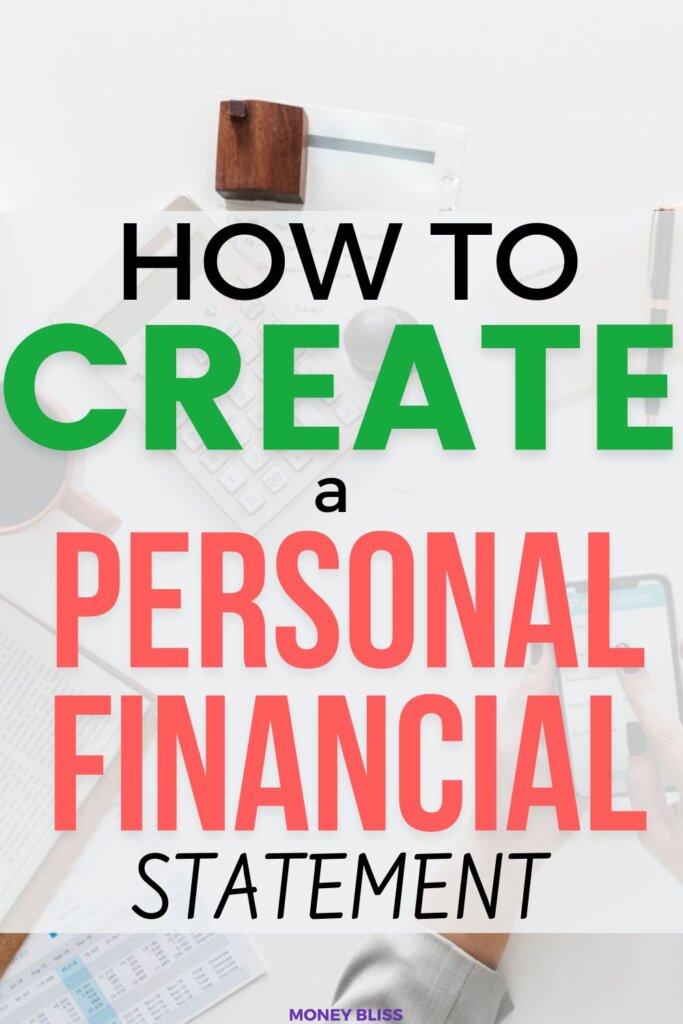
What is a personal financial statement?
A personal financial statement is a document that summarizes your assets, liabilities, and net worth. A PFS can help you understand your financial health so you can make informed decisions about your money.
A personal financial statement template will typically include three sections:
- Assets: This section will list all of the money and property you own.
- Liabilities: This section will list all of the money you owe.
- Net Worth: This section will calculate your net worth by subtracting your total liabilities from your total assets.
Your personal financial statement should be updated on a regular basis, typically once a year. This will help you track your progress and make sure you’re on track to reach your financial goals.
What are the benefits of creating a personal financial statement?

There are many great benefits of a personal financial statement.
By creating a personal financial statement, you can see at a glance how much money you have coming in, going out, and what your net worth is. This information can be extremely helpful in making financial decisions and setting goals.
Benefit #1 – Understand Your Financial Situation
This is why you must spend the extra couple of minutes to create a personal financial statement form.
Most importantly, you get a better understanding of your financial situation. This includes seeing where your money is going each month and how much debt you have.
What we call around here at Money Bliss – the 1000-foot look from above. The outsider’s perspective of what is going on with your finances.
Benefit #2 – Helps you track your progress
When it comes to personal finance, one of the best things you can do is keep track of your progress.
Tracking your progress should be important to you! By seeing everything laid out in front of you, it becomes much easier to make informed financial decisions that will help improve your overall financial picture.
Benefit # 3- Find some areas of improvement

Since a personal financial statement is a document that summarizes your income, expenses, assets, and liabilities in one place it helps you see the financial big picture. Thus, spotting areas for improvement are easier.
For example, if you see that you are spending too much money on non-essential items, you can make changes to improve your financial health.
Benefit #4 – Useful Tool to Set Goals
Next, it can help you set goals. Once you see where you stand financially, you can set goals for paying off debt or saving more money each month.
This aids you to make better financial decisions by providing a clear picture of your financial situation.
Benefit #5 – Snapshot to help you stay motivated

Creating a personal financial statement can be incredibly helpful in staying motivated to save money and achieve your financial goals. Seeing your progress in black and white (or, more accurately, green and red) can be a strong motivator to keep going.
Using a personal finance statement is especially helpful if you’re working towards paying off debt or saving for a specific goal. It can be difficult to stay motivated when you’re not seeing progress, but seeing the numbers going down (or up) can give you the boost you need to keep going.
Benefit #6 – Monitor your financial health
Creating a personal financial statement can help you monitor your financial health and make informed decisions about your spending and saving habits.
- If you see that your expenses are consistently exceeding your income, for example, you may need to make some changes to ensure that you are able to meet your long-term financial goals.
- Easier to spot opportunities to save money or invest in assets that will grow in value over time.
Monitoring your financial health on a regular basis can help you avoid debt problems and keep track of your progress toward financial goals.
What are the types of personal financial statements?

A personal financial statement is a form or spreadsheet detailing a person’s overall financial health. This statement is typically used to apply for business loans or other forms of financing. There are two types of personal financial statements:
- The first type is the balance sheet, which lists a person’s assets and liabilities.
- The second type is the income statement, which details a person’s income and expenses.
The balance sheet provides an overview of a person’s financial situation at a particular point in time, while the income statement shows how much money a person has coming in and going out over a period of time.
Both types of statements are important in helping lenders evaluate a borrower’s ability to repay a loan. As well as for you to monitor your personal situation.
What are the components of a personal financial statement?

A personal financial statement is not just a document that shows how much money you have in your bank account. It also includes other important components to show a well-rounded picture.
Most people know that a personal finance statement includes income, assets, and liabilities. But did you know there are actually four main components of a personal financial statement?
A personal financial statement varies from a traditional balance sheet that is used for a company.
Your income is everything you earn in a year from all sources, including your job, investments, alimony, and more.
You should list all of your sources of income on your personal financial statement so you have a clear picture of what you’re bringing in each month.
- Include all sources of income, even if they are irregular or one-time payments.
- List after-tax income.
- If you are married or have a partner, include their income as well.
- Update your income regularly to reflect any changes (e.g., new job, raise, bonus).
This will help you make informed decisions about your spending and saving.

This is the money you spend each month on things like your mortgage or rent, car payments, groceries, and other necessary expenses.
Here are over 100 personal budget categories for various expenses.
Assets are everything you own like your home equity or the value of your car and can use to pay your debts. This includes cash, savings, investments, property, and possessions.
Calculate your total assets by adding up the value of all your cash, savings, investments, property, and possessions.
So, is a car an asset ? Well it depends if there is a loan against it.
Liabilities
Your liabilities are everything you owe money on. This includes, but is not limited to:
- Student loans
- Credit card debt
- Any other personal loans
Your liabilities also include any money you may owe in taxes.
How to create a personal financial statement – Part 1

There are a few key things you need to know in order to create a personal financial statement.
The first part includes what is needed for your net worth – assets and liabilities. The second part includes your current income, expenditures, and savings.
We will show you next how to collect all of this information, then you can start to work on creating a personal financial statement.
Step #1 – Determine your current assets and business profit
The first is your current assets. Your assets are everything you own and can use to pay your debts. This includes your savings, your home equity, and any investments you have. You will need to know the value of all of these things in order to create an accurate personal finance statement.
To determine the value of your assets, start by looking at your savings. This can be any money you have in the bank, including checking, savings, and money market accounts. Add up the total balance of all these accounts to get your total savings.
Next, determine the value of your home equity. This is the difference between what your home is worth and how much you still owe on it. To calculate this, look up the current value of your home and subtract any outstanding mortgage or other loan balances from it. This will give you an estimate of how much equity you have in your home.
Finally, add up the values of any investments you have. These can include stocks, bonds, mutual funds, and other types of investment accounts. Once you have all these values totaled up, this will give you an estimate of your current assets.
Step #2 – Determine your current liabilities
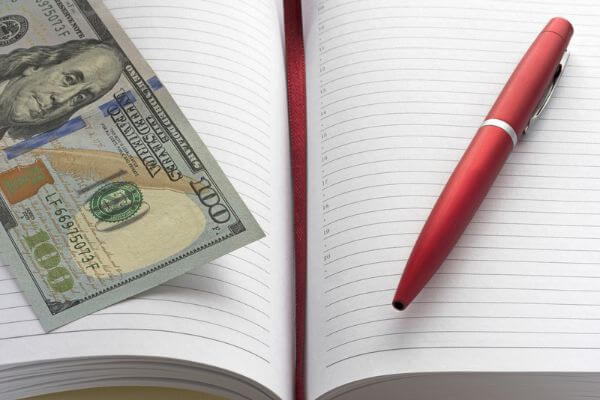
Your current liabilities are all of the debts and financial obligations that you currently have.
This can include things like credit card debt, car loans, student loans, and any other type of loan that you are currently paying off.
To get an accurate picture of your current liabilities, you will need to gather up all of your bills and statements so that you can see exactly how much you owe.
Step #3 – Determine your net worth
Your net worth is your assets – your savings, your home equity, and your stocks and investments – minus your liabilities. To calculate it, simply subtract your total liabilities from your total assets. This will give you your net worth.
Your net worth is a good indicator of your financial health.
It can help you make decisions about saving and investing, and it can also be a useful tool for budgeting. If you want to improve your financial health, focus on increasing your net worth by saving more money and investing in assets that will grow in value over time.
Your goal is to double your liquid net worth quickly.
How to create a personal financial statement – Part 2

Now, you have developed your next worth statement. The next step in creating a personal financial statement is to determine your monthly cash flow of money or annual cash flow.
This second part includes your current income, expenditures, and savings.
Step #1 – Determine your monthly income
Firstly, you will need your income flow section. This could come from your pay stubs, or if you are self-employed, your profit and loss statements.
Your monthly income includes all money that you earn in a month, including salary, wages, tips, commissions, child support, alimony, and any other regular payments that you receive.
Step #2 – Determine your monthly expenses
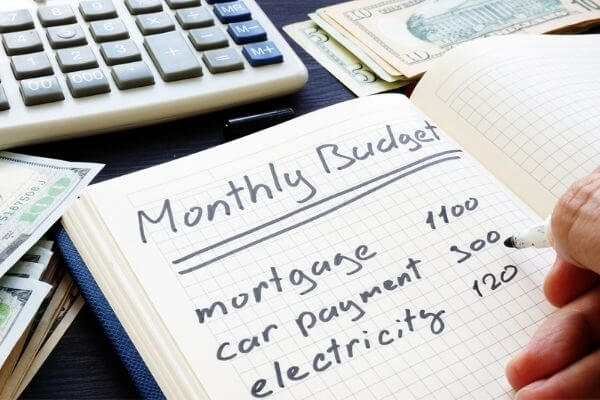
The next piece is to determine your monthly expenses. This includes things like your mortgage or rent, car payments, credit card bills, and any other regular expenses. You’ll also want to factor in occasional expenses, like doctor’s appointments or annual membership fees.
Your expenses can be divided into two categories: fixed and variable.
Fixed expenses are those that remain the same each month, such as rent or mortgage payments, car insurance, and minimum credit card payments. Variable expenses change from month to month and can include items such as groceries, utility bills, entertainment, and clothing.
Step #3 – Determine your monthly savings
Typically, most advice will leave out monthly savings. However, this. is a critical piece to learning how to FI – financial independence.
Once you have both your income and expense information, you can begin to calculate your monthly savings. To do this, simply take your total income and subtract your total expenses. The remaining amount is what you have available to save each month.
Maybe you just calculated this and realize you have a negative number (meaning you spend more than you earn each month), then you will need to make some changes in order to improve your financial situation.
It is important to note that a personal financial statement is not static.
Your income and expenses can change from month-to-month, so it is important to recalculate your statement on a regular basis. Additionally, as you begin to save more money each month, the amount available for savings will increase as well.
How to use a personal finance statement template

A personal financial statement is a snapshot of your financial health at a given point in time. It lists your assets, liabilities, and net worth so you can see the big picture of your finances.
You can use a personal finance statement template to track your progress over time and make changes to improve your financial health.
Here’s how to use a personal finance statement template:
- Enter your information into the template. This includes details about your income, expenses, debts, and assets.
- Review your numbers and calculate your net worth. This is the difference between your total assets and total liabilities.
- Watch for comparisons. Compare your net worth from one period to another to track your progress over time.
- Make tweaks. Make changes in areas where you want to improve, such as increasing savings or paying down debt.
- Repeat steps 1-4 periodically . Then you can see how well you’re doing and make necessary changes
How to interpret a personal finance statement
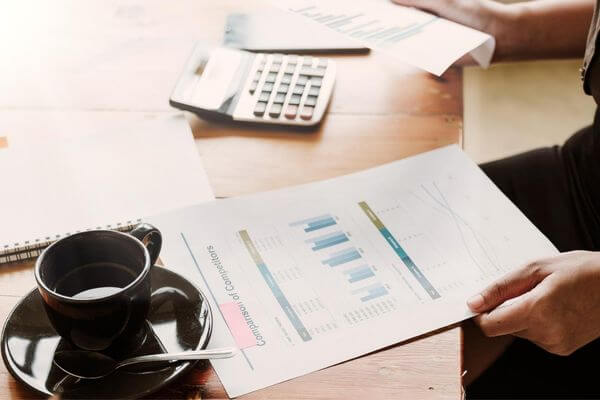
A personal financial statement is a document that shows your current financial health. It lists your assets and liabilities, giving you a clear picture of your net worth.
- Positive net worth means you have more assets than debt.
- Negative net worth means you have more debt than assets.
Your personal financial statement will help you to set financial goals and track your progress over time. For example, if you want to become debt-free within five years, you can use your statement to create a budget and track your progress each year.
If you have a negative net worth, don’t panic! You can improve your financial health by paying off debts and building up your savings.
Creating a budget will help you make the most of your income and make headway on your financial goals.
How to use a personal financial statement to make financial decisions?

This is the important piece of becoming a millionaire.
A personal financial statement can help you see where your money is going each month and make changes to ensure that you are saving enough for your future goals.
Way #1 – Look at your current financial situation
Your personal financial statement is a record of your income and expenses over a period of time. This information can be used to make financial decisions, such as whether to save money or invest in a new business venture.
If you are looking to save money, you will want to compare your total income to your total expenses. If your expenses are greater than your income, you will need to find ways to reduce your spending. You may also want to consider investing in a savings account or retirement fund.
If you are looking to invest in a new business venture, you will want to assess your current financial situation. You will need to determine how much money you can afford to invest and whether or not the venture is likely to be successful.
Doing this analysis before making any decisions can help you avoid making costly mistakes.
Way #2 – Determine your financial goals

There are a few key things to keep in mind when you’re determining your financial goals.
First, you need to think about your short-term and long-term goals.
- Your short-term goals might include things like saving up for a down payment on a house or car or paying off high-interest debt.
- Your long-term goals might include things like saving for retirement or sending your kids to college.
Once you’ve determined your goals, you need to think about how much money you’ll need to reach them. This is where a personal financial statement can come in handy.
This information can help you figure out how much money you have available to put towards your financial goals.
Once you have an idea of how much money you need to reach your financial goals, the next step is to develop a plan for how you’re going to save that money. This might involve setting up a budget and sticking to it, investing in a specific savings account or investment account, or taking advantage of employer matching programs if they’re available.
Making smart financial decisions is important for achieving both your short-term and long-term goals. A personal financial statement can help you determine how much money you need to reach your goals, and develop a plan for saving that money.
Way #3 – Make a budget
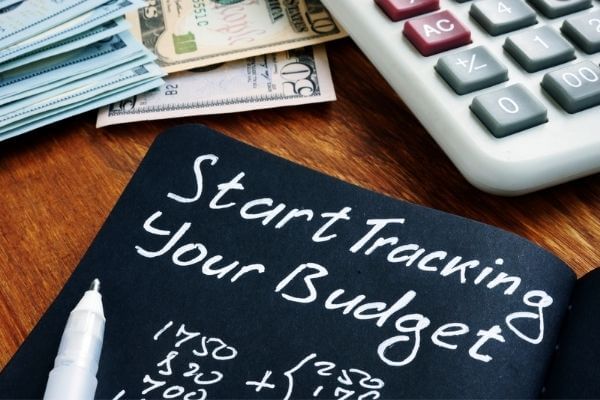
Your personal financial statement can be a helpful tool when you’re trying to make a budget. This document lists your income and expenses and can give you a clear picture of your financial situation.
To use your personal financial statement to make a budget:
- Look at your overall income and expenses. This will give you an idea of where your money is going each month.
- What are Necessary Expenses? Determine which expenses are necessary and which ones you can cut back on.
- Prioritize your List. Make a list of your monthly income and expenses, with the necessary expenses first. And drop the expenses at the bottom of the list.
- How Much is Left? Determine how much money you have left over each month after paying for necessities. This is the money you can use for savings or other goals.
- Adjust your budget as needed based on changes in your income or expenses.
Way #4 – Invest in yourself
There are a lot of things you can do to invest in yourself, but one of the smartest things you can do is to invest in your personal finance education.
In fact, one of the popular millionaire quotes from Warren Buffet is :
Invest in yourself as much as possible. Warren Buffet
Investing in yourself is one of the smartest things you can do.
Way #5 – Stay disciplined
Making financial decisions can be difficult, but if you have a personal financial statement, it can help you stay disciplined.
A personal financial statement is a document that shows your income, expenses, and assets. It can help you track your spending and see where you can save money. That my friend is black and white information.
Making financial decisions can be difficult, but if you have a personal financial statement, it can help you stay disciplined and on track.
What are some common mistakes to avoid when creating a personal finance statement?

There are many common mistakes people make when creating a personal financial statement. This can lead to an inaccurate picture of your financial situation and make it difficult to make informed decisions about your finances.
Any of these common mistakes can also lead to problems down the road because you will be unable to meet your financial obligations.
- Not including all sources of income
- Not including all debts and expenses
- Forgetting to track new sources of income
- Overstating or understating expenses
- Not properly categorizing expenses
- Forgetting to update (or review) the statement regularly
- Not tracking progress over time
- Too scared to seek professional help if needed.
By avoiding these common mistakes, you can create a personal financial statement that accurately reflects your financial situation and helps you make better decisions about your money.
How often should a personal finance statement be updated?
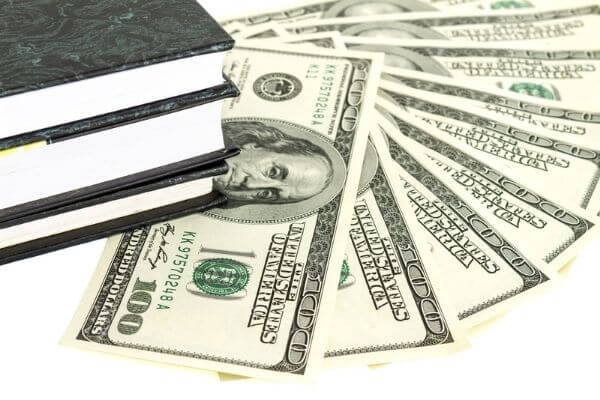
You should update your personal finance statement at least once a year.
However, you may want to update it more frequently if you have significant changes in your income or expenses. For example, you may want to update your personal finance statement after you get a raise or buy a new car.
A Personal Financial Statement Template Example
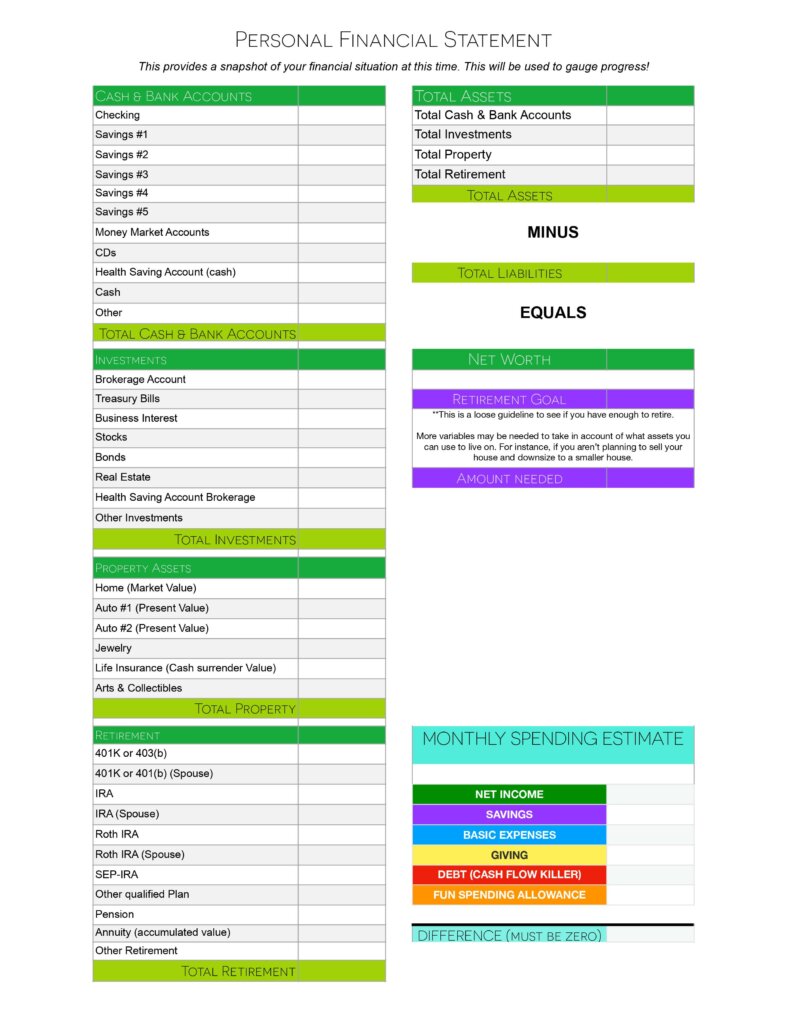
A personal financial statement is a document that summarizes your financial health.
It includes information about your income, expenses, debts, and assets. This information can be used to make informed decisions about your finances.
There are many personal finance statement templates available online. Some banks and financial institutions offer their own templates. You can also find templates in our free resource library. Once you find a template you like, you can download it and fill it out with your own information.
When filling out a personal financial statement template, be sure to include accurate and up-to-date information.
This will give you the most accurate picture of your financial health. Review your statements regularly to track your progress and make changes as needed.
Time to Create A Sample Personal Financial Statement

When creating a personal financial statement, it is important to include all sources of income, not just your salary. This includes any freelance work, investments, or other forms of passive income. Additionally, make sure to include any government benefits or assistance you receive.
Excluding all sources of income will give you an inaccurate picture of your financial situation and make it difficult to create a realistic budget.
This is something you need to spend dedicated time doing to create a personal financial statement worksheet.
Over time, this wealth management tool will help you to become the next millionaire.
Know someone else that needs this, too? Then, please share!!
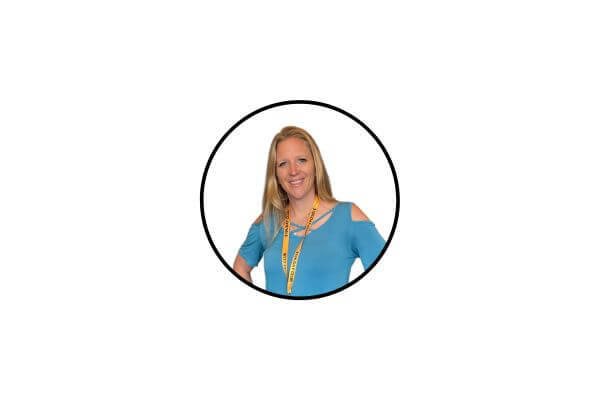
Did the post resonate with you?
More importantly, did I answer the questions you have about this topic? Let me know in the comments if I can help in some other way!
Your comments are not just welcomed; they’re an integral part of our community. Let’s continue the conversation and explore how these ideas align with your journey towards Money Bliss.
There was a template offer that popped up when I first visited the page and then it disappeared. Could you please send me the spreadsheet?
You can go here to subscribe to our email list: https://moneybliss.org/email-subscribe/
Leave a Reply Cancel reply
Your email address will not be published. Required fields are marked *
ACDS PUBLISHING

Understanding Personal Financial Statements: A Comprehensive Guide
Table of content, what’s in this guide, personal balance sheet, how to create a personal balance sheet, calculating and interpreting your net worth, pros of creating a personal balance sheet, personal balance sheet limitations, pro tips on creating and maintaining a personal balance sheet, personal cash flow statement, how to create a personal cash flow statement, calculating and interpreting your net cash flow, pros of creating a personal cash flow statement, personal cash flow statement limitations, pro tips on creating and maintaining a personal cash flow statement, personal balance sheet case study, personal cash flow statement case study, grab your free personal financial statement template here, the bottom line.
Financial literacy isn’t just a skill; it’s a necessity in our complex modern economy. Our financial landscape is filled with many challenges—from managing debt and investments to planning for retirement. A personal financial statement is one key financial document that makes navigating these challenges easy.
Personal financial statements, which comprise a balance sheet and cash flow statement, provide a snapshot of your financial health, allowing you to evaluate your current financial condition, track changes over time, and plan for the future. Imagine seeing, at a glance, areas where you can reduce spending, if your net worth is increasing or decreasing, or if you are on track to meet your financial goals.
That’s the kind of clarity these statements provide. They don’t just contain numbers; they provide insights into your financial health, facilitating better decisions and effective long-term planning. For example, a cash flow statement can reveal if you are spending too much on non-essential items, while a balance sheet can show if your debt is becoming unmanageable.
Additionally, analyzing these statements together provides a broad view of your financial situation, helping you identify potential issues before they become significant problems. For instance, if your cash flow statement shows a consistent surplus, but your balance sheet reveals increasing debt, that might be a sign that you are not using your surplus efficiently to pay down debt.
In this guide, we’ll walk you through the two common types of personal financial statements: the personal balance sheet and the personal cash flow statement. We’ll explain each statement, their typical line items, the benefits of creating them, and their limitations.
Finally, we’ll share some pro tips on creating and maintaining each statement, and we’ll examine two case studies that illustrate how each statement can help individuals make better financial choices. At the end of the guide, you will be able to download a free template to get you started on monitoring your finances.
Let’s dive right in.
In a hurry and can’t read this guide in one go? Download the free PDF version to read whenever you have the chance!
Download Link: Understanding Personal Financial Statements: A Comprehensive Guide
A personal balance sheet provides a snapshot of your financial position at a specific period, typically a month or a year. It outlines what you own (assets), what you owe (liabilities), and the difference between the two, known as your net worth. Assets include your house, car, investments, and savings, while liabilities encompass debts such as your mortgage, car loan, and credit card balances.
For instance, say your assets include a $350,000 house, a $30,000 car, $80,000 in investments, $30,000 in savings, and $10,000 in other assets, totaling $500,000. On the other hand, your liabilities include a $150,000 mortgage, $20,000 car loan, $10,000 credit card debt, $15,000 student loan, and $5,000 in other debts totaling $200,000. In this scenario, your net worth would be $500,000 (Total Assets) – $200,000 (Total Liabilities) = $300,000.
Understanding, creating, and maintaining a personal balance sheet helps you make informed decisions about investments, loans, and other financial matters. For example, by knowing your net worth, you can determine how much debt you can afford for a new home or car, how much you can reasonably invest, or whether you need to focus on paying down existing debt.
A personal balance sheet consists of two major categories: assets and liabilities. You can further divide these categories into subcategories that outline what you own and owe. Let’s briefly examine the typical structure of a personal balance sheet.
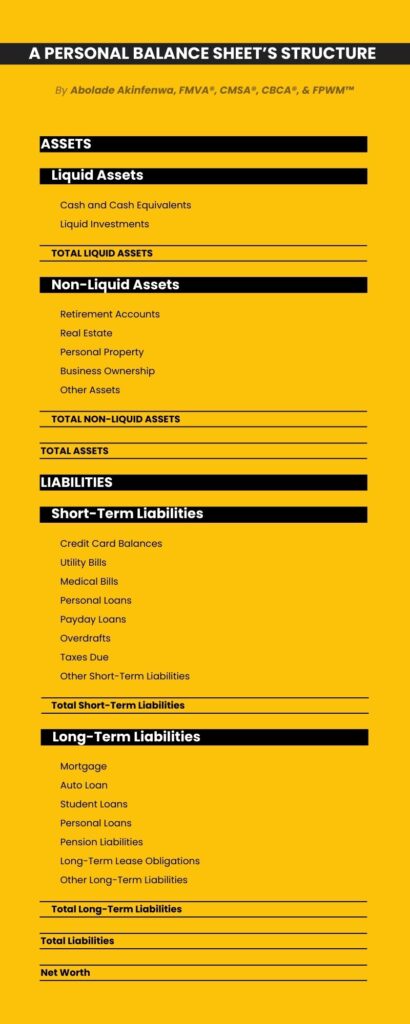
“Assets” is the first section on a personal balance sheet, and it covers everything you own that has a monetary value. These include tangible items like your home, car, and personal belongings, as well as intangible items like investments and savings accounts. Essentially, anything you could sell or cash in for money is considered an asset.
Assets are typically categorized into two groups: liquid and non-liquid assets. Let’s briefly examine the types of assets that fall under each group.
Liqui d Assets
“Liquid Assets” is the first category under the “Assets” section. It includes all assets that can be quickly and easily converted into cash without losing much value. Such assets include the following:
- Cash and Cash Equivalents: This subcategory accounts for physical cash, checking accounts, savings accounts, certificates of deposit, and money market accounts, which are investments easily convertible to cash, making them as liquid as cash.
- Liquid Investments: This subcategory covers stocks, bonds, mutual funds, exchange-traded funds, and other liquid investment assets. You can convert these assets to cash relatively quickly without losing much value.
Non-Liq uid Assets
“Non-Liquid Assets” is the second category under the “Assets” section. This subcategory covers all assets that cannot be easily converted into cash or would lose value in the process. Such assets include the following:
- Retirement Accounts: This subcategory includes all forms of retirement funds you have. While the assets within a retirement account (like a 401(k) or an IRA) may be liquid, there are often penalties and tax consequences for withdrawing funds before a certain age. This is why it is usually classified as a non-liquid asset.
- Real Estate: This subcategory covers the market value of your home, rental properties, or any other real estate properties you own.
- Personal Property: This subcategory includes the value of tangible assets such as cars, jewelry, furniture, electronics, collectibles, and other personal belongings. Note that these items should be valued at what they could be sold for now, not what was initially paid for them, as the value of many items depreciates over time, and overvaluing your assets can result in an inflated net worth.
- Business Ownership: If you own a business, the value of your ownership stake is an asset and should be recorded under this subcategory.
- Other Assets: This subcategory accounts for any other assets not included in the preceding subcategories, such as loans you have given to others, tax refunds expected, etc.
Liabilities
“Liabilities” is the second section on your personal balance sheet, and it represents all debts and financial obligations. These can include various forms of debt, such as mortgages, car loans, credit card balances, and personal loans. Essentially, anything you need to pay back to others, whether to a bank, a credit card company, or a friend, is considered a liability.
Just as with assets, liabilities are also usually categorized into two groups: short-term and long-term liabilities. Let’s briefly examine the types of liabilities that fall under each group.
Shor t-Term Liabilities
“Short-Term Liabilities” is the first category under the “Liabilities” section. It includes all debts that are due within a year. Such liabilities include the following:
- Credit Card Balances: This subcategory highlights all you owe to credit card companies.
- Utility Bills: This subcategory covers all your utility bills, such as electricity, water, gas, and internet.
- Medical Bills: This subcategory includes any outstanding bills you owe for medical services or treatments. This can include doctor’s visits, hospital stays, and prescription medications.
- Personal Loans: This subcategory accounts for any loan you take out for personal reasons, such as to cover unexpected expenses or to consolidate debt, and are due within a year.
- Payday Loans: This subcategory covers all short-term loans typically due on your next payday.
- Overdrafts: This subcategory highlights the amount by which withdrawals from your bank account exceed the available balance.
- Taxes Due: This subcategory includes everything you owe to the government in taxes. This can include income, property, and any other taxes due within a year.
- Other Short-Term Liabilities: This subcategory accounts for every other bill or money you owe and is due within a year, such as insurance premiums, subscription services, gym memberships, and contingent liabilities, which are potential liabilities that depend on a future event.
Long-Term Liabil ities
“Long-Term Liabilities” is the second category under the “Liabilities” section. It includes all debts that are due in more than a year. Such liabilities include the following:
- Mortgage: This subcategory covers every mortgage you’ve taken on your home. It is typically the most significant liability for most people and is paid off over many years, often 15 to 30 years.
- Auto Loan: This subcategory includes any car loans you’ve taken out. These loans are typically paid off over a period of 3 to 7 years.
- Student Loans: This subcategory highlights any student loans you’ve taken out, which typically have a 10- to 30-year repayment period.
- Personal Loans: This subcategory accounts for any loan you take out for personal reasons, such as to cover unexpected expenses or to consolidate debt, and are due after a year.
- Pension Liabilities: This subcategory spotlights the amount you owe to your pension plan if you have borrowed against it.
- Long-Term Lease Obligations: This subcategory includes the amount you owe on any long-term lease, such as a car or equipment lease.
- Other Long-Term Liabilities: This subcategory covers any other long-term obligations that do not fit the preceding categories, such as a lawsuit settlement being paid off over time.
“Net Worth” is the final figure on a personal balance sheet. This figure is a clear indicator of your financial health, and you can calculate it using the following formula:
- Net Worth = Total Assets – Total Liabilities
For instance, let’s assume you own a house valued at $350,000, have a car worth $20,000, a retirement account with $50,000, and a savings account with $10,000, putting your total assets at $430,000. Let’s further assume you have a mortgage balance of $200,000 and a car loan of $15,000, putting your total liabilities at $215,000. In this scenario, your net worth would be:
- Net Worth = $430,000 (Total Assets) – $215,000 (Total Liabilities) = $215,000
This positive net worth of $215,000 implies that you own more than you owe, which is the ideal financial position to be in. Suppose your liabilities had exceeded your assets in the preceding scenario. In that case, you’d have a negative net worth, meaning you owe more than you own.
Your net worth is a crucial measure of your financial stability. A high positive net worth implies that you are in a strong financial position and have effectively managed your income, savings, investments, and debts. A negative net worth, on the other hand, signals the need to reevaluate your financial habits to reduce debts and increase assets to avoid financial insolvency.
Understanding your financial situation is crucial for making informed decisions about your future. A personal balance sheet is a valuable tool for gaining this understanding. Here are some key benefits of creating and maintaining this financial statement:
Increased Financial Awareness
Regularly creating and reviewing your balance sheet increases your awareness of your financial situation. This heightened awareness can lead to better financial decisions, such as avoiding unnecessary debt and expenses, making better investment choices, and being more disciplined with savings.
For instance, if you notice that a large portion of your income is spent on dining out and entertainment, this awareness could lead you to make more disciplined spending choices, such as cooking at home or choosing free entertainment options.
Moreover, understanding your financial situation can also lead to psychological benefits. For example, knowing that you have a manageable level of debt and a solid savings plan reduces financial anxiety and increases confidence in your ability to achieve your financial goals. Additionally, this awareness fosters a sense of control over your finances, encourages a more disciplined approach to spending and saving, and promotes a more positive and proactive outlook towards your financial future.
Snapshot of Financial Health
A balance sheet provides a quick, overall view of your financial health by showing your assets and liabilities at a glance, making it easier to identify financial strengths and weaknesses. For example, if your balance sheet reveals that your credit card debt is more than 50% of your total assets, it’s a clear sign that you need to focus on debt reduction. Ignoring this signal could lead to escalating debt, higher interest payments, and a lower credit score.
Conversely, if your balance sheet shows that your assets are three times greater than your liabilities, that implies positive financial strength. You could leverage this strength by investing in higher-yield assets or taking on manageable debt to invest in opportunities with a high return on investment.
However, it is crucial to approach this cautiously and consider the potential risks involved. Do thorough research or consult a financial advisor before making significant financial decisions.
Wealth Tracking
Creating and updating your personal balance sheet regularly helps you monitor your wealth over time. This ongoing tracking lets you see if you’re progressing toward your financial goals and pinpoint areas needing improvement.
For example, if you observe that the value of your stock portfolio has decreased significantly over the past year, this might indicate that your investment strategy needs to be reevaluated. Failing to take action could result in further losses, considerably reducing your overall wealth.
It’s important to factor in economic variables like inflation when assessing your financial growth. A nominal increase in wealth doesn’t always equate to an actual increase in financial well-being. For instance, a 3% increase in your wealth over the past year may seem positive, but if the inflation rate is 5%, your real wealth has actually decreased by 2%. It’s great to see your wealth grow year after year, but it’s essential to ask yourself: does the growth rate outpace or at least keep up with inflation?
Financial Planning
A personal balance sheet is an effective tool for planning financial goals. By knowing your net worth, you can devise better strategies for saving, investing, or debt repayment, helping you make informed decisions to achieve your financial goals. Let’s say you notice that your net worth is decreasing; it might be time to cut expenses, pay down debt, or reconsider large purchases or investments.
For example, if your net worth has decreased by 10% over the past year, you might decide to sell non-essential assets, reduce discretionary spending, or refinance your debt to lower interest rates. Doing a mix of the preceding will help you increase your net worth.
Additionally, a personal balance sheet can help you create a clear and detailed financial plan. For example, by knowing your net worth, you can set realistic savings and investment goals for the next year.
Remember, it is necessary to regularly revisit and adjust your financial plan and goals as your financial situation changes. Factors that may necessitate a change in your plan include a change in income, unexpected expenses, or changes in your financial goals. For example, if you receive a promotion and a salary increase, you may want to adjust your savings and investment goals accordingly. Similarly, if you incur unexpected medical expenses, you may need to adjust your budget and debt repayment plan .
Advanced Financial Analytics
Creating and maintaining a personal balance sheet makes it easier to calculate and track important personal financial ratios like the debt-to-asset ratio and capitalization ratio. These ratios are crucial for assessing your financial health and stability. For example, the debt-to-asset ratio helps you understand how much of your assets are financed by debt. In contrast, the capitalization ratio helps you understand your financial structure by showing the proportion of debt owed relative to equity owned.
While a personal balance sheet is an indispensable tool for understanding your financial health, planning your financial future, and making informed financial decisions, it’s also important to recognize its limitations. Knowing them helps you better interpret the information your balance sheet provides and understand what additional steps you may need to take to neutralize each limitation. Here are some key limitations of a personal balance sheet:
Doesn't Show Cash Flow
A balance sheet provides a snapshot of your financial situation at a specific point in time but doesn’t show cash flow. A cash flow statement provides a dynamic view of how money is earned and spent over a specific period. This can highlight issues not immediately apparent from the balance sheet, such as a negative cash flow despite a positive net worth. For example, someone might have a high net worth and still have cash flow problems because most of their assets are illiquid (e.g., real estate, long-term investments, etc.). Creating and maintaining a balance sheet and a cash flow statement is a great way to overcome this limitation.
Fluctuating Values
The values of assets and liabilities can fluctuate over time, making the balance sheet a snapshot accurate only at the moment it’s prepared. And this variability can significantly impact your financial planning and decision-making. For example, if you intend to sell some of your stocks, the value of those stocks when preparing the balance sheet may differ from the value at the time of the sale. This discrepancy could result in overestimating or underestimating the sale proceeds in your budget, each having distinct repercussions.
Consider a scenario where you plan to use the sale proceeds to repay debt. If the actual proceeds are lower than anticipated, you may find yourself unable to cover the debt fully, leading to additional interest charges or penalties. For this reason, it’s crucial to update your balance sheet frequently and exercise caution when making financial decisions based on it.
Subjective Asset Valuation
Some assets, like jewelry, art, or antiques, can be difficult to value accurately, making it challenging to create an accurate personal balance sheet. For instance, valuing a piece of art at $12,000 when it’s actually worth $5,000 will inflate your net worth and potentially mislead your financial planning. It’s advisable to consult a professional appraiser for items of significant value to mitigate this limitation.
Dependency on Accurate Data
The effectiveness of a balance sheet depends on the accuracy of the data inputted. Even minor errors in asset or liability values can lead to incorrect conclusions about your financial health. For example, an underestimation of debt by $1000 may seem inconsequential, but when interest is taken into account, the actual value of that debt could be significantly higher over time. This could lead to understating the time and money required to repay that debt.
Creating a personal balance sheet is crucial for anyone interested in managing their finances responsibly. However, the real benefit of a personal balance sheet lies not just in its creation but in regularly updating and using it wisely. Here are some pro tips to help you make the most of your personal balance sheet:
Start with Accurate Information
Gather all your financial documents, such as bank statements, mortgage statements, and credit card bills, before creating your balance sheet. Doing so will help ensure you don’t miss any assets or liabilities.
Categorize Your Assets and Liabilities
Break down your assets and liabilities into categories such as liquid assets (cash, savings), non-liquid assets (real estate, investments), short-term liabilities (credit card debt, other debts due within a year), and long-term liabilities (mortgage, student loans).
Consider Future Liabilities
Include expected future liabilities, such as a child’s college education, a planned home renovation, or future taxes, in your personal balance sheet. Doing so will help make your financial planning more accurate and effective.
For example, let’s say you’re planning for your child’s college education. You can estimate this future liability by researching the current tuition fees of the college your child might attend and its historical growth rate.
Suppose the current tuition fee is $30,000 per year, and historically, the tuition fee has increased by 5% annually. You can estimate that in 10 years, the tuition fee would be approximately $48,890 per year ($30,000 × (1 + 0.05)^10). This estimation will help you plan and save accordingly.
Use Conservative Values
Be conservative when estimating the value of your assets. This means using the lower end of an estimated value range and being cautious when including assets whose value is highly uncertain. Overestimating the value of your assets provides a false sense of financial security and leaves you unprepared for unexpected financial downturns.
Be Thorough
Being conservative matters a lot in creating an accurate personal statement, but so does being thorough. Ensure you include all your assets and liabilities, even if they seem insignificant. Small amounts can add up over time and may affect your financial health more than you realize. Assets and liabilities commonly overlooked include:
- Digital assets like cryptocurrency;
- Intellectual property (e.g., copyrighted material, patents);
- Collectibles (e.g., rare coins, stamps); and
- Prepaid expenses (e.g., prepaid insurance, prepaid rent).
Liabilities:
- Outstanding medical bills;
- Unpaid taxes;
- Personal loans from friends or family; and
- Any accrued interest on existing loans.
Update Regularly
Update your balance sheet at least every quarter or when there is a significant change in your assets or liabilities, such as receiving an inheritance, buying a house, and paying off or incurring a debt. Recording changes in your assets and liabilities is the best way to spot trends you would have otherwise missed. Moreover, doing so helps make your balance sheet more accurate.
Review Past Balance Sheets
While you should update your personal balance sheet at least four times a year, it’s a good idea to monitor it regularly. Set a schedule for reviewing your personal balance sheet, such as monthly or quarterly. Regularly reviewing past balance sheets can help you identify trends, understand how your financial situation has changed, and make more informed decisions about the future.
Use Alongside A Cash Flow Statement
To better understand your financial health, use your personal balance sheet together with a personal cash flow statement. While the balance sheet provides a snapshot of your financial health at a specific point in time, the cash flow statement shows how you earned your money or spent it over a specific period. Using both financial statements will help you identify trends, gain more insights, and make more informed financial decisions.
Take Advantage of Tools and Templates
There are various tools and templates available online, such as Microsoft Excel templates, personal finance apps, or online budgeting tools that offer personal balance sheet templates. You can start with a basic template from Microsoft Excel and customize it to include categories specific to your financial situation, like adding a section for digital assets or future liabilities.
Reflect and Act
After creating your balance sheet, reflect on your financial situation. Are you meeting your financial goals? Do you need to adjust your spending or saving habits? Use your balance sheet as a tool for making informed financial decisions.
Seek Professional Help
If you are dealing with a complex financial situation, such as managing investments across multiple platforms, dealing with significant debt, or planning for retirement, it might be beneficial to seek advice from a certified financial planner or wealth manager. A financial planner can help you create a comprehensive financial plan, while a wealth manager can help you manage your investments and optimize for tax efficiency.
A personal cash flow statement tracks how much cash you’re earning and where it’s being spent over a specific period, typically a month or a year. This statement provides valuable insights into how you are managing your cash resources, enabling you to understand your spending patterns and make better financial decisions.
A personal cash flow statement records cash inflows and outflows during a specific period. Think of it as a story of your personal finances from a cash perspective, showing you where your money came from (inflows), where it went (outflows), and the net difference between the two. If your inflows exceed your outflows, then you’ll have a positive cash flow. Conversely, if your outflows exceed your inflows, then you’ll have a negative cash flow.
For example, let’s say your monthly cash inflows (salary, freelance work, etc.) are $5,000, and cash outflows (rent, utilities, groceries, etc.) amount to $3,200. In this scenario, your personal cash flow statement for that month would show a surplus of $1800, money you can put towards savings, investment, or other financial goals.
A personal cash flow statement typically consists of two main sections: cash inflows and cash outflows, which can be further divided into various categories and subcategories.
When creating a personal cash flow statement, it is essential to break down your cash inflows and outflows into different line items that track your income sources and expenditures. This detailed breakdown provides a clearer view of your financial situation, helping you identify potential areas for savings or producing additional income.
Let’s briefly examine the typical structure of a personal cash flow statement.
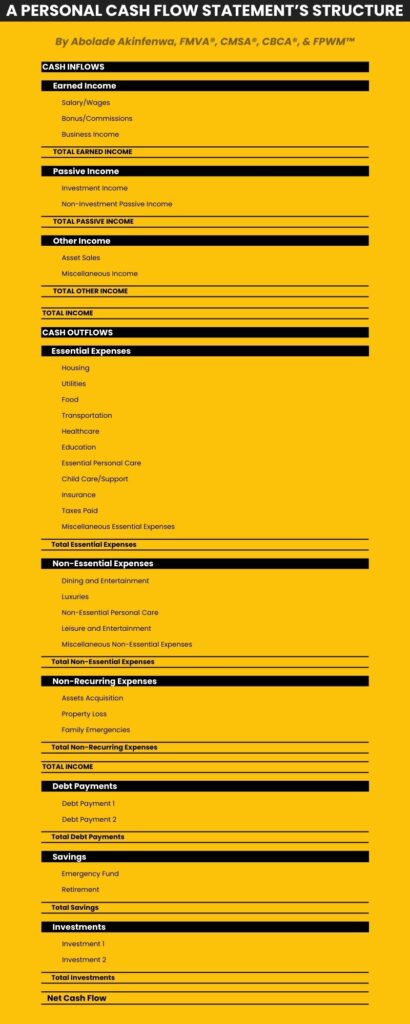
Cash Inflows
“Cash inflows” is the first section on a personal cash flow statement; it covers all the money that comes into your possession during a specific period, usually monthly or yearly. These inflows can include your salary, bonuses, dividends from investments, rental income, money received from selling assets, gifts, or any other sources of income. Essentially, any money you receive or earn is a cash inflow.
Cash Inflows are typically grouped into three categories: earned income, passive income, and other income. Let’s briefly examine the types of cash inflows that fall under each category.
Earned Income
“Earned Income” is the first category under the “Cash Inflows” category. It covers any money you earn by providing a service, working a job, or running a business.
Common types of income under this category include the following:
- Salary/Wages: This line item covers your primary income source, typically earned through employment or self-employment. This is generally the largest portion of your income.
- Bonus/Commissions: This line item includes any additional income from your primary employment beyond your salary or wages.
- Business Income: If you have a side business or gig, such as freelance work or a small online business, include the gross income (i.e., income after business-related expenses are deducted) under this subcategory. For example, if you have a freelance business and earn $10,000 monthly but have $2,000 in business-related expenses (such as advertising, supplies, etc.), you would record $8,000 ($10,000 – $2,000) under this subcategory.
Passiv e Income
“Passive Income” is the second category under the “Cash Inflows” section, and it highlights any cash you earn without active, ongoing effort after the initial groundwork or setup. This category typically contains the following subcategories:
- Investment Income: This subcategory accounts for stock dividends, bond interest payments, rental property income, or any other income you earn from your investments. For example, if you own 100 shares in a company that pays $1 in dividends per share quarterly, you would receive $100 every quarter. This $100 would be recorded under this subcategory.
- Non-Investment Passive Income: This subcategory covers any income from passive ventures or endeavors where capital investment isn’t the primary driver, such as royalties from intellectual property and ad revenue from websites, blogs, or YouTube channels.
Oth er Income
“Other Income” is the third category under the “Cash Inflows” section, and it includes any other money you receive that doesn’t fall under the categories of earned or passive income. Typical subcategories under this category include the following:
- Asset Sales: If you’ve sold any assets like cars, furniture, investments, etc., the cash generated from these sales would be recorded under this subcategory. For example, if you sold a car for $10,000, this amount would be recorded under the “Sale of Assets” subcategory. Similarly, if you sold shares of stock for a total of $5,000, this amount would also be recorded here.
- Miscellaneous Income: This subcategory tracks all miscellaneous income sources like alimony, child support, social security income, lottery winnings, gifts, and inheritance. For example, if you received $500 as a reimbursement from your employer for work-related expenses, $200 as a refund from a returned purchase, and $50 as cashback from your credit card, you would record these amounts under this subcategory.
Cash Outflows
“Cash outflows” is the second section on a personal cash flow statement, and it represents all the money you spend during a specified period, typically monthly or yearly. These outflows include expenses such as rent or mortgage payments, utility bills, groceries, transportation costs, loan repayments, and entertainment.
Essentially, any money you spend is a cash outflow, and unlike cash inflows, which increase your available funds, cash outflows reduce them. Let’s briefly examine the types of cash outflows that fall under this section.
Ess ential Expenses
“Essential Expenses” is the first category under the “Cash Outflows” section. It tracks all necessary costs you incur to maintain your basic standard of living. In other words, this category covers every cash you spend on needs rather than wants. Another way to think about essential expenses is that they are cash you need to spend to survive and function in society. Common types of expenses under this category include the following:
- Housing: This subcategory covers your mortgage or rent payments, maintenance, property tax, and renters’ insurance, among other housing-related costs. If you own a home, you will have property tax expenses; if you rent, you may have renters’ insurance. Accounting for these variations makes your cash outflows more accurate.
- Utilities: This subcategory accounts for basic services vital to everyday living, such as electricity, gas, water, sewer, trash, internet service, and phone bills.
- Food: This subcategory typically includes groceries and other essential food-related expenses, like school lunches for children or meals for elderly family members.
- Transportation: This subcategory highlights car payments, gas, insurance, maintenance, public transit, ride-share costs, vehicle registration, tolls, parking, and all other transportation-related expenses.
- Healthcare: This subcategory covers health insurance premiums, out-of-pocket medical costs, prescriptions, alternative therapies, health supplements, and all other healthcare-related expenses.
- Education: This subcategory includes tuition, textbooks, online courses, professional development, workshops, seminars, conferences, school supplies for kids, tutoring, educational software, and other education-related expenses.
- Essential Personal Care: This subcategory includes clothing, personal grooming, dental care, cosmetics, skincare, and other personal care-related expenses.
- Child Care/Support: This subcategory covers child care costs, school fees, child support payments, and other related expenses.
- Insurance: This subcategory spotlights life insurance, disability insurance, and other insurance-related expenses.
- Taxes Paid: This subcategory covers any additional tax payments you may make, such as estimated tax payments, that are not automatically deducted from your income.
- Miscellaneous Essential Expenses: This subcategory covers essential expenses that don’t fit into the preceding subcategories. These include prescription glasses or contacts, special dietary needs, home safety equipment, professional licensing or certification fees, alimony payments, bank fees, etc.

Non-Essential Expenses
“Non-Essential Expenses” is the second category under the “Cash Outflows” section. All expenses that aren’t necessary for your survival or basic comfort but contribute to your lifestyle and happiness fall under this category. These expenses are typically optional and can be reduced or eliminated if necessary. Common types of non-essential expenses under this category include the following:
- Dining and Entertainment: This subcategory covers cash spent on meals, snacks, and beverages from restaurants, cafes, takeout, and delivery services.
- Luxuries: This subcategory includes any cash spent on things like jewelry, high-end electronics, designer clothing, etc.
- Non-Essential Personal Care: This subcategory accounts for expenses that are not necessary for maintaining basic health and hygiene. These expenses include spa and massage treatments, luxury cosmetics and skincare, tanning, etc.
- Leisure and Entertainment: This subcategory includes a wide range of expenses like gym memberships, subscriptions (like Netflix, Spotify, club memberships, etc.), hobbies, vacations, cultural events, theater, concerts, etc.
- Miscellaneous Non-Essential Expenses: This subcategory accounts for all the expenses that are not crucial for your survival, basic comfort, or regular lifestyle but don’t fit into any existing non-essential expenses subcategories. These include gifts, donations, decor, special occasions, pet-related expenses, books, magazines, etc.
Non-Recurring Expenses
“Non-Recurring Expenses” is the third category under the “Cash Outflows” section. It accounts for essential or non-essential expenses that don’t occur regularly or predictably and don’t fit under preceding categories and subcategories. For example, acquisition of assets, legal fees, or any unexpected expenses like family emergencies. Common types of non-recurring expenses under this category include the following:
- Assets Acquisition: If you’ve bought assets like property, vehicles, or other large purchases, the cash used for these acquisitions would be recorded under this subcategory.
- Property Loss: Expenses related to replacing lost or stolen property not covered by insurance, such as replacing stolen electronics, furniture, or other valuable items, can be recorded here.
- Family Emergencies: Expenses related to unexpected family emergencies, such as travel costs for a family member’s funeral or medical emergency, can be recorded here.
Debt Payments
“Debt Payments” is the fourth category under the “Cash Outflows” section. Any money used to repay the principal and interest on your debts is recorded under this category.
“Savings” is the fifth category under the “Cash Outflows” section. It tracks whatever income is set aside for future use, such as an emergency fund, retirement, or specific financial goals. Common line items under this category include goal-specific savings, emergency funds, retirement accounts, etc.
Investments
“Investments” is the sixth category under the “Cash Outflows” section. It covers any money used to purchase assets with the expectation that they will generate a return in the future. Line items commonly recorded under this category include stocks, bonds, mutual funds, real estate, start-up investments, etc.
Calculating your net cash flow is the final step in creating your personal cash flow statement. Net cash flow is the figure you get after subtracting your total cash outflows from your total cash inflows. It’s a vital indicator of your financial liquidity. You can calculate this figure using the following formula:
- Net Cash Flow = Total Cash Inflows – Total Cash Outflows
To illustrate how to calculate net cash flow, let’s consider the following example. Assume your total cash inflows, which include your salary of $4,000, investment income of $500, and other income sources of $500, come to $5,000 per month. And your total cash outflows, encompassing costs such as housing ($1,500), food ($500), transportation ($400), personal expenses ($400), and debt repayments ($900), sum up to $3,700 per month. In this case, your net cash flow would be:
- Net Cash Flow = $5,000 (Inflows) – $3,700 (Outflows) = $1,300
Your net cash flow is $1,300 in this scenario, indicating a positive cash flow. This means you earn more than you spend, leaving you with excess cash that can be used for savings, investments, or reducing debt.
Interpreting your net cash flow involves understanding what the number means for your financial health. A positive net cash flow indicates a healthy financial situation where you live within your means and have leftover income to allocate towards savings, investments, or debt repayments. This is generally an ideal financial position to be in.
Conversely, if your net cash flow is negative, you spend more than you earn. A negative net cash flow could be due to one-time large expenses or indicate a pattern of overspending. If it’s the former, this may not pose a long-term issue, but if it’s the latter, you may need to reassess your budget and spending habits. Creating a detailed budget, tracking your expenses, and identifying areas where you can cut back or increase your income can help turn a negative net cash flow into a positive one.
To summarize, your net cash flow reveals whether you’re living within your means or overspending. It can serve as a wake-up call to adjust your spending habits or as a green light that you’re on track with your financial plans.
Creating a personal cash flow statement is more than just a financial exercise; it can help you develop a roadmap to your financial freedom. Whether you’re struggling with budgeting, debt, or planning for the future, a personal cash flow statement can provide invaluable insights. Here are some of the key benefits you unlock when you create a personal cash flow statement:
Regularly updating and reviewing your personal cash flow statement not only helps you keep tabs on your financial situation but also increases your awareness of your spending habits. For example, regularly reviewing your personal cash flow statement might help you notice that you’re consistently spending $100 monthly on takeout. Noting this pattern is the first step toward deciding whether this is an area where you can and should cut back.
Interestingly, as you regularly review your personal cash statement, you will become more conscious of your spending decisions in real time, not just when you review your statement.
Enhanced Budgeting
A personal cash flow statement can help you create a more detailed and practical budget by identifying exactly where your money is going. And with a comprehensive cash flow statement, you can easily spot areas where you may need to cut back on your expenses or allocate more funds.
For instance, let’s say you notice that your grocery bill has increased significantly over the last six months. You can delve deeper to understand why and adjust your budget or behavior accordingly. You may decide to allocate more funds to your grocery budget for the following months or find ways to reduce grocery expenses. This real-time feedback loop is invaluable for effective budget management.
Set Achievable Financial Goals
By highlighting your disposable income or the money left over after all cash outflows have been accounted for, a personal cash flow statement can help you set realistic financial goals, both short-term and long-term. This way, you’re not just aiming mindlessly but setting achievable targets.
For instance, if your cash flow statement reveals that you have $300 left each month after essential expenses, setting a goal to save $500 a month would be unrealistic and could leave you frustrated. On the other hand, a realistic goal based on your actual disposable income, such as saving 20% ($60) monthly, can improve your financial self-esteem and encourage you to maintain or improve your financial habits.
Evidently, setting achievable goals not only improves your financial self-esteem but also leads to a sense of accomplishment that motivates you to set and achieve more financial goals.
Effective Debt Management
Effective debt management is critical to eliminating liabilities within the shortest possible time to avoid unnecessary interest payments. A well-structured cash flow statement can reveal non-essential expenses you could cut back on or eliminate to free up funds to fast-track your debt repayment.
Consider this scenario: After creating a monthly cash flow statement, you notice spending $200 on gourmet coffee and $150 on streaming services. Making coffee at home and canceling a few subscriptions could free up $350 monthly or $4,200 annually!
When redirected to your credit card debt, this surplus can significantly reduce your outstanding balance and the interest you’d otherwise accrue, fast-tracking your path to being debt-free. Similar savings can be spotted in areas like dining out, unused gym memberships, or impulse online purchases.
Remember, staying disciplined with your repayment strategy is vital to managing and eliminating debt. Timely repayments free you from debt faster and improve your credit score, opening doors for better financial opportunities in the future.
Deeper Financial Analysis
The insights a personal cash flow statement provides are not limited to tracking income and expenses. By using your cash flow data, you can easily calculate key personal financial ratios. An example of these ratios is the debt-to-income ratio, calculated by dividing total monthly debt payments by total income.
Personal financial ratios are more than just numbers. Despite popular misconceptions, they are performance indicators that can help anyone gauge their financial health and make informed decisions. For example, lenders consider a debt-to-income ratio higher than 0.36 as a red flag. Your ratio exceeding this threshold may result in higher interest rates on loans or make it challenging to secure credit. In such a situation, it’s prudent, therefore, to reduce existing debt before attempting to take on additional debt.
By creating and regularly updating your cash flow statement, you can actively monitor these ratios, spot trends, and make adjustments to reach financial goals more effectively.
While a personal cash flow statement is invaluable for understanding your finances, it has limitations, which, when recognized, can lead to a more accurate interpretation of your data. Here are a few limitations to remember when analyzing a personal cash flow statement.
Doesn't Reflect Future Commitments
A cash flow statement primarily captures present transactions and doesn’t account for upcoming financial obligations like loan repayments or planned investments. For instance, if you’ve recently agreed to a car lease or plan to enroll in a long-term course next year, these commitments won’t appear in your current statement, potentially underestimating future expenses. You can neutralize this limitation by creating a forward-looking budget alongside your cash flow statement.
Doesn't Reflect Total Wealth
A cash flow statement won’t reflect the value of assets such as your home, car, investments, or savings, thus not fully representing your wealth. A balance sheet, on the other hand, provides a snapshot of your assets, liabilities, and net worth, offering a comprehensive view of your overall wealth. As such, it’s important to use your cash flow statement together with a balance sheet to get a complete picture of your current financial health.
Potential for Missed Expenditures
It’s easy to overlook some expenses, especially smaller or infrequent ones, which can make your cash flow statement inaccurate. One way to mitigate this limitation is by meticulously tracking all cash outflows, no matter how small. You can do this by using an expense tracking app, keeping all receipts, or reviewing bank statements.
Provide a Snapshot of a Specific Period
A personal cash flow statement only provides a snapshot of your cash inflows and outflows for a specific period, typically a month or a year. It does not reflect changes in your financial situation over time. For instance, if you faced a significant medical expense in January and then maintained a strict budget for the next few months, a cash flow statement for April might not reflect the financial strain you experienced at the start of the year. To track your financial progress, you need to regularly update and review your cash flow statement and compare it with previous periods.
Understanding your cash flow is essential for managing your finances effectively. A personal cash flow statement enables you to identify patterns, plan for the future, and make informed financial decisions. However, to get the most out of your personal cash flow statement, you need to be diligent in its creation and usage. Here are some pro tips for creating and using a personal cash flow statement effectively:
Record Everything
Record all inflows and outflows, no matter how small, to make your cash flow as accurate as possible. Even minor discrepancies can lead to an inaccurate picture of your financial health. For example, small expenses like daily coffee or occasional parking fees are often overlooked. However, a $5 daily coffee adds up to $150 monthly and $1,825 yearly. Assuming your yearly expenses amount to $36,000, you underreport your expenses by ~5% every year.
Use Accurate Time Frames
Make sure the time frame for your cash flow statement matches the time frame for your budget and financial goals. A monthly cash flow statement is appropriate for most people because many expenses and income sources occur on a monthly basis. However, if you have significant irregular expenses or variable income, you may need to review and update your cash flow statement more frequently, such as weekly or bi-weekly.
Be Specific
When noting your expenses, avoid grouping them into overly broad categories to understand your spending patterns better. For example, instead of vaguely listing $150 for “utilities,” you could break it down: $50 for “electricity,” $40 for “water,” $30 for “internet,” and $30 for “gas.” Such granularity can reveal surprising spending habits, like unusually high water cost that prompts leak checks or water conservation efforts.
However, it’s also crucial not to overwhelm your cash flow statement with excessive detail. Excessive details can clutter your statement, making it harder to identify overall trends or patterns quickly. For example, instead of listing “Netflix,” “Hulu,” and “Disney+” separately, group them under “Streaming Services”. The goal is to find a categorization balance that ensures your cash flow statement remains streamlined yet insightful, setting the stage for well-informed financial decisions.
Distinguish Between Essential and Non-Essential Expenses
Distinguishing between essential and non-essential expenses helps you identify areas to cut costs. Essential expenses are the basic costs incurred to maintain a safe and healthy living standard; they cover the fundamental needs required to live and work in modern society. Such expenses include groceries, housing, healthcare, utilities, and transportation. On the other hand, non-essential expenses are costs that enhance your life but aren’t vital for your basic survival. Dining out, vacations, luxury shopping, streaming services, etc., are non-essential expenses.
Note that essential expenses can differ based on individual circumstances and lifestyles. For example, if you work from home, high-speed internet becomes a necessity, whereas someone without remote work might view it as a luxury. It’s essential to recognize that what’s necessary for one person might be a luxury for another. Tailor your cash flow statement to reflect your unique needs and priorities.
Plan for Emergencies
Always ensure that you maintain a financial buffer for emergencies and unexpected expenses. Aim to set aside at least 3-6 months’ worth of living expenses in an easily accessible account. This duration is often optimal as it provides adequate coverage for scenarios like unexpected job losses, sudden medical bills, or major home repairs.
Keep your emergency fund in a high-yield savings account, where your money remains readily accessible and earns interest. You might also consider diversifying your emergency fund by putting a portion in money market accounts or short-term certificates of deposit for potentially higher returns.
Review and Adjust Regularly
Your cash flow statement is a dynamic document that should be reviewed and updated regularly. Regular updates help you stay on top of your finances and make necessary adjustments promptly. Update your cash flow statement as regularly as possible. Monthly updates are standard, but you may want to update more infrequently if your inflows and outflows rarely change.
Identify Areas for Cost Reduction
Make it a habit to regularly review your cash flow statement to pinpoint areas where you can trim expenses. If, for instance, you notice a significant portion of your money goes into dining out, consider cooking at home more often to reduce costs. Similarly, evaluate monthly subscriptions to see if there are any you no longer utilize, or consider cheaper alternatives to recurring expenses, ensuring every dollar is spent wisely.
Identify Opportunities to Increase Income
Review your cash flow statement regularly to identify opportunities for increasing your income. This could include asking for a raise, starting a side hustle, or investing in income-generating assets. For instance, if you have a skill like graphic design, you could begin freelancing and taking on small projects in your free time. Alternatively, investing in income-generating assets like dividend stocks or real estate can also increase your income.
Set Realistic Goals
Setting achievable goals for savings, investments, and debt repayment is crucial. For example, if your monthly income is $3,000, setting a goal to save $1,500 monthly may be unrealistic after accounting for all other expenses. Always consider all your essential expenses before setting aside a savings goal.
Use Technology
Using a financial tracking app or software can help you keep track of expenses and minimize omissions. Many apps like Mint, YNAB, Spendee, and PocketGuard offer features that can help you track your expenses, set budgets, and monitor your investments. Look for an app that allows you to categorize your expenses, set alerts for overspending, and provide a visual representation of your financial health.
Pair With Balance Sheet
Your personal cash flow statement is one part of your financial profile. Pairing it with a balance sheet provides more accurate insights into your financial status, allowing you to identify areas of vulnerability, such as looming debts, and opportunities, like potential investments.
By tracking your monthly net cash flow statement from the cash flow statement and your net worth from the balance sheet, you can strategically plan for future investments, debt repayments, and savings. For instance, if your cash flow statement shows a consistent surplus each month, but your balance sheet reveals high-interest debt, it might be wise to allocate some surplus towards that debt reduction.
Feel free to seek assistance from a financial advisor or planner if creating and managing your cash flow statement seems overwhelming. While a financial advisor can be helpful for anyone, it is especially beneficial for those with more complex financial situations, such as multiple income streams, significant debts, or an extensive investment portfolio. For example, if you have $20,000 in credit card debt, a financial planner can help you develop a plan to pay it off within a realistic timeframe.
Meet Sarah, a 24-year-old recent graduate who has just started her first job as a graphic designer in a reputable advertising agency. Now, with a steady income and eager to start on the right financial footing, she has decided to create a personal balance sheet to gain insight into her financial health.
Sarah has some student loans, a personal loan she took for a family emergency, has been using a credit card for daily expenses, and is living in a rented apartment. Although she had saved some money from part-time jobs during college, she’s unsure how her assets measure up against her debts. She aims to clear her debts, invest more, and contribute more to her retirement fund.
After reading this comprehensive guide on personal financial statements, Sarah decided to create a personal balance sheet to understand her financial status clearly and develop a financial plan.
Creating the Personal Balance Sheet
Sarah sets aside a weekend to organize her financial documents, online accounts, and other financial information to compile a comprehensive list of her assets and liabilities. She then begins by listing all her assets and liabilities meticulously.
LIQUID ASSETS
- Checking Account: $3,200
- Savings Account: $5,500
- Total Liquid Assets: $9,000
NON-LIQUID ASSETS
- Retirement Account (401k): $1,000 (from her new job)
- Investment Portfolio (a diversified set of index funds): $2,700
- Car: $10,000 (current market value)
- Total Non-Liquid Assets: $13,700
- Total Assets: $22,700
LIABILITIES
SHORT-TERM LIABILITIES
- Credit Card Debt (20.93% annual percentage rate): $2,500
- Utility Bills (monthly): $200
- Personal Loan from a Friend (to be repaid within a year): $1,000
- Total Short-Term Liabilities: $3,700
LONG-TERM LIABILITIES
- Student Loans (10-year loan term; 6% fixed interest rate): $25,000
- Car Loan (7-year loan term; 9% annual percentage rate): $8,000
- Total Long-Term Liabilities = $33,000
- Total Liabilities = $36,700
- Net Worth = -$14,000
Interpretation and Action
Upon analyzing her Personal Balance Sheet, Sarah finds herself with a negative net worth, largely because of her student and car loans. She decides to take the following actions:
- Credit Card Payoff: Prioritize paying off her credit card debt first, as it has the highest interest rate (20.93%), and then pay off the car loan next, since it has the second-highest interest rate (9%). To achieve this, she decided to allocate 60% more of her monthly disposable income towards paying off the credit card debt.
- Student Loan: Since her student loan has a low single-digit interest rate, Sarah figures there’s no pressing need to rush clearing her student loan. Maintaining her current monthly payment is more financially prudent, especially since student loan interest payments are tax deductible. However, she also knows paying off the loan earlier can save her some interest payments. For that reason, she plans to increase her student loan payments if she gets a chance to do so.
- Emergency Savings: Sarah understands the importance of having an emergency fund. Hence, she decides to save 20% of her disposable income each month until she accumulates a year’s worth of living expenses.
- Retirement Planning: Continue contributing to her 401k to take advantage of her employer’s match and the power of compound interest.
- Investing: Sarah decides to postpone increasing her investment allocation until she has paid off her credit card debt. She understands that it will be challenging to generate real investment returns, seeing as the interest rate on credit card debt exceeds her portfolio’s annualized return.
- Cash Flow Statement: Create a detailed personal cash flow statement to monitor her income and expenses. Doing so will help her identify expenses she can cut back on and allocate more funds toward her debt repayment and savings goals.
Benefits Sarah Gained from Creating a Personal Balance Sheet
- Increased Financial Awareness: By creating her personal balance sheet, Sarah became more aware of her financial situation, which helped her to make informed financial decisions. She decided to prioritize paying off her credit card debt, postpone increasing her investment allocation until her high-interest debts were paid off, and start building an emergency fund. This heightened awareness also reduced her anxiety about her finances and increased her confidence in achieving her financial goals.
- Snapshot of Financial Health: The balance sheet provided Sarah with an overall view of her financial status, revealing that her liabilities significantly exceeded her assets. Her negative net worth was a clear signal that she needed to focus on debt reduction and savings. Identifying this financial weakness allowed her to create a targeted plan to improve her financial health.
- Financial Progress Tracking: By regularly updating her personal balance sheet, Sarah can monitor her wealth over time and see if she is progressing toward her financial goals. For example, as she pays off her debts, she will see a reduction in her liabilities and an increase in her net worth.
- Financial Planning: Creating the personal balance sheet enabled Sarah to begin creating a financial plan. She was able to set realistic goals for saving and debt repayment, giving her a structured path forward.
- Advanced Financial Analytics: Creating a personal balance sheet made it easier for Sarah to calculate and track important personal financial ratios. For example, she could calculate her debt-to-asset ratio and use this information to make informed decisions about debt repayment and borrowing.
Limitations Sarah Overcame
- Doesn’t Show Cash Flow: While the personal balance sheet provided a snapshot of her financial situation, it did not show her cash flow. Recognizing this limitation, Sarah decided to create a detailed personal cash flow statement to monitor her income and expenses. Doing so would help her identify areas where she could cut back and allocate more funds toward her debt repayment and savings goals.
- Fluctuating Values: Sarah understood that the values of assets and liabilities could fluctuate over time. To mitigate this limitation, she decided to update her balance sheet every quarter to ensure that it always reflected her current financial situation.
- Dependency on Accurate Data: Any oversights or inaccuracies could paint an incomplete picture of Sarah’s financial status, potentially leading her to make ill-informed decisions. To overcome this limitation, she meticulously included every asset and liability, no matter how small, and validated the values by checking her bank statements, credit card statements, investment account statements, and other financial records. Additionally, she used financial management apps to automatically pull and consolidate data, further enhancing the accuracy of her balance sheet.
- Subjective Asset Valuation: Knowing that misvaluing her assets can make her balance sheet inaccurate, Sarah used the current market value for her car and checked the most recent statements for her savings and investment accounts.
Pro Tips Sarah Followed
- Regular Updates: Sarah set a reminder to update her Personal Balance Sheet every quarter to track her financial growth and to recalibrate her plans as needed.
- Be Thorough: Sarah included all her assets and liabilities, no matter how small, to ensure her balance sheet was comprehensive.
- Accurate Valuation: As mentioned earlier, Sarah made sure to use the current market value for her car and checked the most recent statements for her savings and investment accounts.
Creating a personal balance sheet was a transformative experience for Sarah. The exercise gave her the information and motivation she needed to take control of her financial future. It provided her with a clear and comprehensive view of her financial situation, enabling her to create a targeted plan to improve her financial health.
Before creating her balance sheet, Sarah often felt overwhelmed by the abstract notion of “net worth” and “financial health.” But after this exercise, these abstract worries solidified into tangible numbers and action points.
Though she started with a negative net worth, Sarah now has a roadmap for eliminating debts and increasing her assets. With a clear roadmap in place, she is now confident in her ability to manage her finances effectively and work towards a secure financial future. This is all thanks to the simple yet enlightening exercise of creating and maintaining her personal balance sheet.
Having already evaluated her net worth via her Personal Balance Sheet, Sarah recognized the importance of tracking her monthly income and expenses. She knows that understanding her cash flows will help her stay on course with her financial goals.
As a recent graduate thrust into the real world with her first job, Sarah was determined not to succumb to the all-too-familiar pitfalls of unchecked spending and minimal savings. Earning a consistent paycheck ($4,500) and living by herself means she has inflows and outflows to monitor closely. And with goals like repaying debts, building an emergency fund, and future investments in mind, it became clear to Sarah that she needed a comprehensive tool to keep tabs on her money.
Creating the Personal Cash Flow Statement
Taking another weekend, Sarah organizes her bank statements, pay stubs, bills, expense-tracking app printouts, and receipts she has accumulated over the past month to compile an accurate cash flow statement. She then begins listing down all sources of cash inflow and outflow.
CASH INFLOWS
- Base Salary from Advertising Agency: $3,420 (after a 24% tax deduction)
FREELANCE INCOME
- Graphic Design Projects: $996
INVESTMENT RETURNS
- Dividends from Index Funds: $35
NON-INVESTMENT PASSIVE INCOME
- Affiliate Marketing from Personal Design Blog: $236
- Ad Revenue from Personal Design Blog: $112
- Sale of Old Laptop: $300
- Total Cash Inflows: $5,099
CASH OUTFLOWS
ESSENTIAL EXPENSES
- Rent: $1,200
- Groceries: $300
- Utilities: $200 (including electricity, water, and internet)
- Gas (for transportation): $120
- Health Insurance (deducted from her salary): $120
- Car Insurance: $90
- Personal Care (haircuts, toiletries): $60
- Public Transportation: $50
- Total Essential Expenses: $2,140
NON-ESSENTIAL EXPENSES
- Dining Out: $250
- Miscellaneous Purchases: $100
- Gym Membership: $50
- Streaming Services (Netflix, Spotify): $25
- Total Non-Essential Expenses: $475
DEBT PAYMENTS
- Student Loan Repayment: $300
- Car Loan Payment: $200
- Credit Card Minimum Payment: $100
- Personal Loan from a Friend: $100
- Total Debt Payments: $700
- Savings Account Contribution: $500
- 401k Contribution: $225 (5% of her gross salary)
- Total Savings: $775
- Investment into Index Funds: $200
- Total Investments: $200
- Total Cash Outflows: $4,140
- Net Cash Flow: $959
Upon completing her personal cash flow statement, Sarah is relieved to see a positive net cash flow of $959. This positive net cash flow means she’s living within her means and has a surplus after paying all monthly obligations.
However, she recognized that $300 of the surplus was from a one-time sale of her old laptop—an irregular form of income. This meant that her consistent net cash flow was actually $659—give or take a couple of dollars due to the unpredictable nature of her non-investment passive income.
With this in mind, she decided to further allocate her net cash flow towards:
- Caution with Irregular Income: She decided not to rely on her asset sale for recurring monthly expenses. Instead, she’d treat such irregular income as a bonus.
- Debt Acceleration: In a bid to reduce high-interest liabilities faster, Sarah allocated an additional $395.40 (or 60% of her monthly disposable income) from her regular surplus towards her credit card debt, increasing the monthly payments to $495.40. By so doing, she will pay off the debt within five months, as long as she doesn’t incur any more credit card debt.
- Emergency Fund Boost: After accounting for the credit card payment, she decides to save an extra $131.80 (20% of $659) from her regular surplus to her emergency fund, bolstering her financial safety net.
- Personal Loan Payoff Strategy: Remembering the personal loan she took for a family emergency, she committed to allocating 20% of her monthly disposable income to repay it faster. This would amount to $131.80 (20% of $659) every month, in addition to the $100 she currently pays, taking the total monthly payment to $231.80. Sticking to this payment strategy will help her pay off the loan within five months, as opposed to the initial ten.
- Non-Essential Expenditures Review: Sarah observed that her dining out expenses were relatively high. So, she decided to reduce it by $100 (40%) and divert that amount towards her student loan repayment. Doing so will help her pay off the loan three years earlier and save $2,868 in interest payments.
- Car Loan: Sarah realized that by paying $200 monthly, she was already on track to pay off her car loan within four years, three years earlier than her loan term, saving $1,270 in potential interest payments.
- Passive Income : Seeing the success of her personal design blog, Sarah considered investing more time to increase her advertising and affiliate marketing income.
Benefits Sarah Gained From Creating a Personal Cash Flow Statement
- Enhanced Financial Awareness: Sarah better understood her financial status after creating her cash flow statement. This exercise helped her spot patterns, such as her monthly takeout habit, making her reconsider her spending decisions.
- Precise Goal Setting: Sarah found it easier to set financial targets once she knew her disposable income. This ensured she wasn’t setting herself up for failure but creating realistic and achievable financial objectives.
- Effective Debt Management: Completing the cash flow statement, Sarah was better poised to manage her multiple debts. Recognizing the prudence of paying off high-interest debts first, she drafted a strategic repayment plan, saving herself from additional interest accumulation.
- Temporary Snapshot: Sarah understands that the cash flow statement provides data for a specific period. Thus, she plans to review and update hers regularly to monitor financial changes over time.
- Wealth Indication: Aware that the cash flow statement doesn’t reflect total wealth, Sarah complements it with a personal balance sheet to gauge her overall financial health.
- Expenditure Accuracy: Sarah addresses the challenge of overlooked expenses by meticulously tracking every penny, often using financial tracking apps for accuracy.
- Regular Review: Sarah plans to diligently review her cash flow statement every month to ensure it’s updated and reflective of her current financial state.
- Digital Assistance: Sarah uses expense-tracking apps to automatically categorize and track her inflows and outflows to streamline the process.
- Emergency Preparedness: Sarah maintains an emergency fund, understanding the unpredictability of life events.
Creating a personal cash flow statement was yet another financial eye-opener for Sarah. Just as the personal balance sheet had given her insight into her net worth, the cash flow statement offered her a clear view of her monthly financial activities. She could see where her money came from and where it was going, ensuring she wasn’t merely flying blind when managing her monthly expenses and income.
Sarah’s positive net cash flow is encouraging, and her decisions to accelerate debt repayment and consistently increase her savings demonstrate both proactiveness and foresight. Armed with the insights from her cash flow statement, she is now even more committed to fortifying her financial resilience, ensuring she is not just living for the present but is also well-prepared for the future.
Want a hassle-free way to monitor your finances? Download our free personal financial statement template. Easy to use and fully customizable—it’s everything you need to keep track of your assets, liabilities, and cash movements.
DOWNLOAD: Personal Balance Sheet and Cash Flow Statement Template
How to Use the Template
The template is a view-only file and can’t be edited. To use, click on “File” and then select “Make a copy.” This will get you a copy of the template that can be modified.
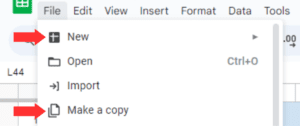
Don’t request edit access, please.

In today’s complex economy, tools like a personal balance sheet and a cash flow statement aren’t just nice to have—they’re essential for understanding and navigating your finances.
Think of the balance sheet as a still photo, capturing your assets and liabilities in one snapshot. It allows you to calculate your net worth and can highlight areas for improvement. In contrast, the cash flow statement is like a movie, illustrating the dynamic movement of your funds and providing insights into your liquidity and spending habits.
Individually, these statements offer valuable insights, such as revealing if you’re splurging too much on non-essentials or if debts are becoming unmanageable. Yet, when combined, they paint a comprehensive picture of your financial standing and habits. This dual perspective ensures you know your financial status and how your habits shape it.
As illustrated by the case studies, creating these financial statements is simple, especially with the templates provided in this guide. These templates simplify the process of creating these statements with their auto-calculating fields and intuitive categories. They guide you through the process, minimizing errors. Remember, keeping these statements updated is vital to ensuring you’re on track with your financial goals, be it budgeting, retirement planning, or merely gauging your fiscal health.
Feel free to work with a financial planner or advisor if you find it challenging to decipher and leverage insights from your financial statements. Not only can they assist you in understanding these statements, but they can also offer personalized strategies tailored to your unique financial situation. Beyond helping you interpret these statements, they can also advise on investments, tax planning, and other aspects of financial management that might be outside your comfort zone.
By understanding, creating, and maintaining these personal financial statements, you’ll have the tools to navigate your financial journey, align your financial habits with your goals, and build a secure financial future.
Remember, maintaining and reviewing these statements regularly is as important as their initial creation. As your financial situation evolves—like with a new job, added expenses, or changes in investments—your statements should reflect those shifts to offer accurate insights. So, watch those numbers, make wise choices, and remember—you’ve got this!
About the Author
Abolade Akinfenwa is a multi-certified finance professional. He’s certified as a Financial Modeling & Valuation Analyst (FMVA)®, Capital Markets & Securities Analyst (CMSA)®, Commercial Banking & Credit Analyst (CBCA)®, Financial Planning & Wealth Management Professional (FPWM)™, and FinTech Industry Professional (FTIP)™. With over three years of experience as a Financial Writer, Abolade specializes in helping finance professionals build authority and generate qualified leads for their services. Interested in collaborating or seeking insights? Connect with Abolade via LinkedIn or Twitter , or email him at [email protected] .
Recommended reading
- Assessing Your Financial Health: Top 22 Personal Financial Ratios
- How to Plan Your Finances Using the 50-30-20 Budgeting Rule (Plus Case Study and Free Template)
Get newsletter updates from Alex
No spam. Just the highest quality ideas that will teach you how to build wealth via the stock market.
Leave a Reply Cancel reply
Your email address will not be published. Required fields are marked *
Save my name, email, and website in this browser for the next time I comment.

- Contact Alex
- Free Resources
Subscribe to my newsletter and get a free ebook!
Answers to your questions, faster
What are you looking for?
Getting Started
How to Create your Own Personal Financial Statement—and Why You Want One
A personal financial statement gives you a clear idea of how you’re doing financially at any point in time. it's also a great tool to bring with you when applying for a loan..

Before you start any journey, you need to know where you are. That’s exactly what a Personal Financial Statement is for—it’s a snapshot of your personal financial position at a specific point in time. A step up from a spending plan, it lists your assets (what you own), your liabilities (what you owe) and your net worth (your liabilities subtracted from your assets). Understanding where you are now means you can set future goals and create a plan to get you there. A personal financial statement can also be a great tool when you’re ready to apply for a loan or mortgage.
First, list all of your assets which include (but aren’t limited to):
Your cash: The total balance of your checking accounts, savings accounts and any cash on hand.
Your retirement accounts: Include your 401k and your IRA, if you have them.
Value of significant assets: These are your bigger assets and usually include items like a car, real estate, life insurance policies, material property, and jewelry. Some item values may be variable, so be sure to check in and update those numbers from time to time.
Real Estate: Any piece of real estate or personal property that you own. Specify what type of property it is, the date it was purchased, and its original cost and present market value. You should also include the name and address of each mortgage holder (even if it’s you), each mortgage account number, the balance and status of each mortgage, as well as the amount of money paid against each mortgage every month or year.
Life insurance: List your beneficiaries, insurance company details, and the face amount and cash surrender value of each policy.
Accounts and notes receivable: "They Owe You’s"—any debts or payments that are personally owed to you.
Then, add up the liabilities:
Unpaid taxes: Back taxes, not estimates.
Total real estate mortgage owed, if applicable.
Money you owe institutions: List money you owe to any institution that loaned money to you, such as personal or student loans.
All unpaid accounts: Create an itemized list of open credit card balances or other unpaid accounts. Be sure to list the amount owed and interest impacts.
Unpaid installment accounts: This item will have two lists: one for auto payments and one for any other payments made in installments—but NOT mortgage payments as they should be listed separately.
Life insurance loan, if you have one.
Contingent liabilities: These are kept separate from normal liabilities because they are, in a sense, not your sole responsibility. List any liabilities you have accrued through endorsement or co-creation of, say, a business, as well as any other special debts such as legal claims or responsibilities and income tax provisions on the federal level.
Notes payable to banks and others: List the names and addresses of people and institutions to whom you owe money (the “Noteholders”), as well as original debts, current remaining debts, child support, and the amounts and frequencies of payment installments.
The total sum of all liabilities: Remember, this number must be accurate because you’ll subtract it from your assets to calculate your net worth.
Final math time: Your Assets - Your Liabilities = Your Net Worth
You’re leaving firsttechfed.com and entering a website that First Tech does not control. Payments made through ACI Payments, Inc. are processed by ACI Payments, Inc. and credited to your account at First Tech. All associated fees are charged by ACI Payments, Inc. We have provided this link for your convenience, but we’re not responsible for the content, links, or the privacy or security policies of this website.
Free Financial Templates for a Business Plan
By Andy Marker | July 29, 2020
- Share on Facebook
- Share on LinkedIn
Link copied
In this article, we’ve rounded up expert-tested financial templates for your business plan, all of which are free to download in Excel, Google Sheets, and PDF formats.
Included on this page, you’ll find the essential financial statement templates, including income statement templates , cash flow statement templates , and balance sheet templates . Plus, we cover the key elements of the financial section of a business plan .
Financial Plan Templates
Download and prepare these financial plan templates to include in your business plan. Use historical data and future projections to produce an overview of the financial health of your organization to support your business plan and gain buy-in from stakeholders
Business Financial Plan Template

Use this financial plan template to organize and prepare the financial section of your business plan. This customizable template has room to provide a financial overview, any important assumptions, key financial indicators and ratios, a break-even analysis, and pro forma financial statements to share key financial data with potential investors.
Download Financial Plan Template
Word | PDF | Smartsheet
Financial Plan Projections Template for Startups

This financial plan projections template comes as a set of pro forma templates designed to help startups. The template set includes a 12-month profit and loss statement, a balance sheet, and a cash flow statement for you to detail the current and projected financial position of a business.
Download Startup Financial Projections Template
Excel | Smartsheet
Income Statement Templates for Business Plan
Also called profit and loss statements , these income statement templates will empower you to make critical business decisions by providing insight into your company, as well as illustrating the projected profitability associated with business activities. The numbers prepared in your income statement directly influence the cash flow and balance sheet forecasts.
Pro Forma Income Statement/Profit and Loss Sample

Use this pro forma income statement template to project income and expenses over a three-year time period. Pro forma income statements consider historical or market analysis data to calculate the estimated sales, cost of sales, profits, and more.
Download Pro Forma Income Statement Sample - Excel
Small Business Profit and Loss Statement

Small businesses can use this simple profit and loss statement template to project income and expenses for a specific time period. Enter expected income, cost of goods sold, and business expenses, and the built-in formulas will automatically calculate the net income.
Download Small Business Profit and Loss Template - Excel
3-Year Income Statement Template

Use this income statement template to calculate and assess the profit and loss generated by your business over three years. This template provides room to enter revenue and expenses associated with operating your business and allows you to track performance over time.
Download 3-Year Income Statement Template
For additional resources, including how to use profit and loss statements, visit “ Download Free Profit and Loss Templates .”
Cash Flow Statement Templates for Business Plan
Use these free cash flow statement templates to convey how efficiently your company manages the inflow and outflow of money. Use a cash flow statement to analyze the availability of liquid assets and your company’s ability to grow and sustain itself long term.
Simple Cash Flow Template

Use this basic cash flow template to compare your business cash flows against different time periods. Enter the beginning balance of cash on hand, and then detail itemized cash receipts, payments, costs of goods sold, and expenses. Once you enter those values, the built-in formulas will calculate total cash payments, net cash change, and the month ending cash position.
Download Simple Cash Flow Template
12-Month Cash Flow Forecast Template

Use this cash flow forecast template, also called a pro forma cash flow template, to track and compare expected and actual cash flow outcomes on a monthly and yearly basis. Enter the cash on hand at the beginning of each month, and then add the cash receipts (from customers, issuance of stock, and other operations). Finally, add the cash paid out (purchases made, wage expenses, and other cash outflow). Once you enter those values, the built-in formulas will calculate your cash position for each month with.
Download 12-Month Cash Flow Forecast
3-Year Cash Flow Statement Template Set

Use this cash flow statement template set to analyze the amount of cash your company has compared to its expenses and liabilities. This template set contains a tab to create a monthly cash flow statement, a yearly cash flow statement, and a three-year cash flow statement to track cash flow for the operating, investing, and financing activities of your business.
Download 3-Year Cash Flow Statement Template
For additional information on managing your cash flow, including how to create a cash flow forecast, visit “ Free Cash Flow Statement Templates .”
Balance Sheet Templates for a Business Plan
Use these free balance sheet templates to convey the financial position of your business during a specific time period to potential investors and stakeholders.
Small Business Pro Forma Balance Sheet

Small businesses can use this pro forma balance sheet template to project account balances for assets, liabilities, and equity for a designated period. Established businesses can use this template (and its built-in formulas) to calculate key financial ratios, including working capital.
Download Pro Forma Balance Sheet Template
Monthly and Quarterly Balance Sheet Template

Use this balance sheet template to evaluate your company’s financial health on a monthly, quarterly, and annual basis. You can also use this template to project your financial position for a specified time in the future. Once you complete the balance sheet, you can compare and analyze your assets, liabilities, and equity on a quarter-over-quarter or year-over-year basis.
Download Monthly/Quarterly Balance Sheet Template - Excel
Yearly Balance Sheet Template

Use this balance sheet template to compare your company’s short and long-term assets, liabilities, and equity year-over-year. This template also provides calculations for common financial ratios with built-in formulas, so you can use it to evaluate account balances annually.
Download Yearly Balance Sheet Template - Excel
For more downloadable resources for a wide range of organizations, visit “ Free Balance Sheet Templates .”
Sales Forecast Templates for Business Plan
Sales projections are a fundamental part of a business plan, and should support all other components of your plan, including your market analysis, product offerings, and marketing plan . Use these sales forecast templates to estimate future sales, and ensure the numbers align with the sales numbers provided in your income statement.
Basic Sales Forecast Sample Template

Use this basic forecast template to project the sales of a specific product. Gather historical and industry sales data to generate monthly and yearly estimates of the number of units sold and the price per unit. Then, the pre-built formulas will calculate percentages automatically. You’ll also find details about which months provide the highest sales percentage, and the percentage change in sales month-over-month.
Download Basic Sales Forecast Sample Template
12-Month Sales Forecast Template for Multiple Products

Use this sales forecast template to project the future sales of a business across multiple products or services over the course of a year. Enter your estimated monthly sales, and the built-in formulas will calculate annual totals. There is also space to record and track year-over-year sales, so you can pinpoint sales trends.
Download 12-Month Sales Forecasting Template for Multiple Products
3-Year Sales Forecast Template for Multiple Products

Use this sales forecast template to estimate the monthly and yearly sales for multiple products over a three-year period. Enter the monthly units sold, unit costs, and unit price. Once you enter those values, built-in formulas will automatically calculate revenue, margin per unit, and gross profit. This template also provides bar charts and line graphs to visually display sales and gross profit year over year.
Download 3-Year Sales Forecast Template - Excel
For a wider selection of resources to project your sales, visit “ Free Sales Forecasting Templates .”
Break-Even Analysis Template for Business Plan
A break-even analysis will help you ascertain the point at which a business, product, or service will become profitable. This analysis uses a calculation to pinpoint the number of service or unit sales you need to make to cover costs and make a profit.
Break-Even Analysis Template

Use this break-even analysis template to calculate the number of sales needed to become profitable. Enter the product's selling price at the top of the template, and then add the fixed and variable costs. Once you enter those values, the built-in formulas will calculate the total variable cost, the contribution margin, and break-even units and sales values.
Download Break-Even Analysis Template
For additional resources, visit, “ Free Financial Planning Templates .”
Business Budget Templates for Business Plan
These business budget templates will help you track costs (e.g., fixed and variable) and expenses (e.g., one-time and recurring) associated with starting and running a business. Having a detailed budget enables you to make sound strategic decisions, and should align with the expense values listed on your income statement.
Startup Budget Template

Use this startup budget template to track estimated and actual costs and expenses for various business categories, including administrative, marketing, labor, and other office costs. There is also room to provide funding estimates from investors, banks, and other sources to get a detailed view of the resources you need to start and operate your business.
Download Startup Budget Template
Small Business Budget Template

This business budget template is ideal for small businesses that want to record estimated revenue and expenditures on a monthly and yearly basis. This customizable template comes with a tab to list income, expenses, and a cash flow recording to track cash transactions and balances.
Download Small Business Budget Template
Professional Business Budget Template

Established organizations will appreciate this customizable business budget template, which contains a separate tab to track projected business expenses, actual business expenses, variances, and an expense analysis. Once you enter projected and actual expenses, the built-in formulas will automatically calculate expense variances and populate the included visual charts.
Download Professional Business Budget Template
For additional resources to plan and track your business costs and expenses, visit “ Free Business Budget Templates for Any Company .”
Other Financial Templates for Business Plan
In this section, you’ll find additional financial templates that you may want to include as part of your larger business plan.
Startup Funding Requirements Template

This simple startup funding requirements template is useful for startups and small businesses that require funding to get business off the ground. The numbers generated in this template should align with those in your financial projections, and should detail the allocation of acquired capital to various startup expenses.
Download Startup Funding Requirements Template - Excel
Personnel Plan Template

Use this customizable personnel plan template to map out the current and future staff needed to get — and keep — the business running. This information belongs in the personnel section of a business plan, and details the job title, amount of pay, and hiring timeline for each position. This template calculates the monthly and yearly expenses associated with each role using built-in formulas. Additionally, you can add an organizational chart to provide a visual overview of the company’s structure.
Download Personnel Plan Template - Excel
Elements of the Financial Section of a Business Plan
Whether your organization is a startup, a small business, or an enterprise, the financial plan is the cornerstone of any business plan. The financial section should demonstrate the feasibility and profitability of your idea and should support all other aspects of the business plan.
Below, you’ll find a quick overview of the components of a solid financial plan.
- Financial Overview: This section provides a brief summary of the financial section, and includes key takeaways of the financial statements. If you prefer, you can also add a brief description of each statement in the respective statement’s section.
- Key Assumptions: This component details the basis for your financial projections, including tax and interest rates, economic climate, and other critical, underlying factors.
- Break-Even Analysis: This calculation helps establish the selling price of a product or service, and determines when a product or service should become profitable.
- Pro Forma Income Statement: Also known as a profit and loss statement, this section details the sales, cost of sales, profitability, and other vital financial information to stakeholders.
- Pro Forma Cash Flow Statement: This area outlines the projected cash inflows and outflows the business expects to generate from operating, financing, and investing activities during a specific timeframe.
- Pro Forma Balance Sheet: This document conveys how your business plans to manage assets, including receivables and inventory.
- Key Financial Indicators and Ratios: In this section, highlight key financial indicators and ratios extracted from financial statements that bankers, analysts, and investors can use to evaluate the financial health and position of your business.
Need help putting together the rest of your business plan? Check out our free simple business plan templates to get started. You can learn how to write a successful simple business plan here .
Visit this free non-profit business plan template roundup or download a fill-in-the-blank business plan template to make things easy. If you are looking for a business plan template by file type, visit our pages dedicated specifically to Microsoft Excel , Microsoft Word , and Adobe PDF business plan templates. Read our articles offering startup business plan templates or free 30-60-90-day business plan templates to find more tailored options.
Discover a Better Way to Manage Business Plan Financials and Finance Operations
Empower your people to go above and beyond with a flexible platform designed to match the needs of your team — and adapt as those needs change.
The Smartsheet platform makes it easy to plan, capture, manage, and report on work from anywhere, helping your team be more effective and get more done. Report on key metrics and get real-time visibility into work as it happens with roll-up reports, dashboards, and automated workflows built to keep your team connected and informed.
When teams have clarity into the work getting done, there’s no telling how much more they can accomplish in the same amount of time. Try Smartsheet for free, today.
Discover why over 90% of Fortune 100 companies trust Smartsheet to get work done.
Personal Financial Statement Template
Creating and maintaining your own Personal Financial Statement is useful for 4 main purposes: (1) Gaining a good financial education, (2) Creating and evaluating your budget, (3) Applying for business loans, and (4) Applying for personal loans.
If you already know why you need one, and why you want to use Excel to create one, then go ahead and download the template below. If you'd like to learn more about it, continue reading this page.
Personal Financial Statement
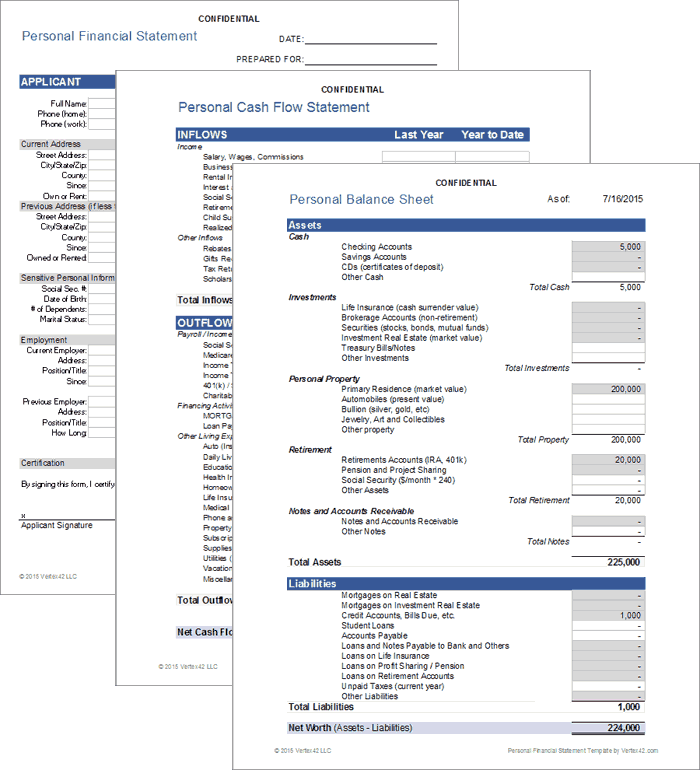
License : Personal Use (not for distribution or resale)
"No installation, no macros - just a simple spreadsheet" - by Jon Wittwer
If you would like to use this Personal Financial Statement in your business to assist your clients, you may purchase the commercial-use version.
Return Policy : 60 Days
License : Commercial Use
Description
- Personal Balance Sheet - for listing assets and liabilities and calculating net worth.
- Cash Flow Statement - for listing all your inflows and outflows and calculating your net cash flow.
- Details Worksheet - for listing individual account balances and the details for your properties and loans.
- Info Sheet - for listing contact info that is typically required in loan applications (e.g. names and addresses of the applicant and co-applicant).
It also includes calculations for some common financial ratios:
- Basic Liquidity (BLR) Ratio = Total Liquid Assets / Total Living Expenses :: How many months can you live on your liquid assets without any income? This ratio uses info from both the balance sheet and the cash flow statement. It's one of the really cool things that your PFS can tell you.
- Debt-to-Income (DTI) Ratio = Annual Debt Payments / Annual Income :: A ratio commonly used by lenders to determine how risky of an investment you will be. It should be below about 35% to be considered to have an acceptable level of debt. This comes from the cash flow statement.
- Debts-to-Assets Ratio = Total Liabilities / Total Assets :: Indicates the degree of leverage that is used by a person or company to finance their assets. The higher this ratio the less financial flexibility you have. This comes from the balance sheet.
Why is a PFS useful for creating and evaluating a budget?
If you have already created and follow a budget, your PFS is basically half done. A personal cash flow statement is almost exactly the same thing as a budget, except that a budget is a plan or projection, and your cash flow statement lists your actual earnings and expenses.
A cash flow statement helps you create your budget. Your budget helps you plan how you are going to allocate your net cash flow (hoping of course that your net cash flow is positive).
Why does a PFS help you increase your financial education?
Did you already know the relationship between a cash flow statement and a budget? It's not that the PFS is going to teach you directly. The point is that to accurately complete your personal financial statement you are going to need to ask a lot of questions, and probably do a lot of Google searching, to figure out why such-and-such is a liability, or what exactly is an asset, etc.
Using the template will give you a big head start, but don't assume that everything I've included in the spreadsheet is 100% correct or that it is organized optimally for your needs. Use it as a template - it is just a framework to help you get started. Verify all formulas and make sure you understand exactly how things are calculated.
Why is a PFS used in applying for loans?
A lender needs to evaluate the risk of lending money to you. One of the ways they do that is by analyzing your income and how much debt you currently have. They can get that information from your personal financial statement.
If you are applying for loans, banks will likely have their own personal financial statement (PFS) forms for you to fill out (I've linked to a couple in the references at the bottom of this page). But, if you are already maintaining your own PFS in Excel, then that will make the process MUCH easier.
The Personal Balance Sheet
Step 1: list all your assets.
An asset is something that you own that has exchange value. You may really love your pet rock, but it's probably not an asset. Your financial assets are your cash, savings, checking account balances, real estate, pensions, etc.
Watch out for the cells that are highlighted gray. These are values that come from the Details worksheet. If you overwrite the formula, you'll need to fix it.
Click on the links labeled "Schedule 1" or "Schedule 2" to go directly to the spot on the Details worksheet for entering those assets.
Step 2: List all your Liabilities
Liabilities are your debts and other unpaid financial obligations. Future expenses such as fuel for your car are not liabilities, but unpaid bills are.
Step 3: Calculate Net Worth = Assets - Liabilities
The full market value of your home is an Asset . The amount you still owe on the mortgage is a Liability . The difference is what you call call Home Equity . In a typical business balance sheet, the terms Owner's Equity or Shareholders Equity are the same as Net Worth : Owner's Equity = Assets - Liabilities.
The Personal Cash Flow Statement
Step 1: list all your inflows.
Inflows include all sources of income (wages, dividends, etc.) and whatever else puts money in your pocket.
The Inflows are grouped into "Income" and "Other Inflows", because some financial ratios are based on "Income" and not all inflows are necessarily considered income (such as tax returns, reimbursements, or gifts). You'll need to decide what should be considered income, perhaps by consulting with your accountant.
If your home or stocks increase in value, there is no cash inflow until you sell them. So, realized capital gains (the profits from the sale of property) are inflows, but unrealized capital gains (the gain in value of unsold property) are not.
Step 2: List all your Outflows
Categorizing your outflows is important if you want to calculate certain financial ratios. For example, the "Payroll Deductions" category consists of things deducted from your paycheck. The net income used by the Debt Service Ratio is your gross income minus these deductions.
Why aren't insurance premiums listed under payroll deductions? You can list them there if you want to. But, if you didn't have any income, you would still want to have health insurance, so I find that including health insurance under living expenses is more convenient for calculating the "Total Living Expenses" used by the BLR ratio.
The "Financing Activities" category of outflows is used to determine your total debt payments. That total is used by the debt-to-income ratios. For these ratios, the mortgage payment includes the escrow payment (property tax and insurance) in addition to interest and principal.
Step 3: Calculate Net Cash Flow = Outflows - Inflows
One of the first things you need to learn about personal finance is how to calculate your net cash flow. That is simply the sum of all your inflows (wages, investment income, gifts, and whatever else puts money in your pocket) minus the sum of your outflows (everything that takes money out of your pocket).
References and Resources
- SBA PFS Form (PDF) at www.sba.gov - This is an example PFS used when applying for an Small Business Association (SBA) loan.
- Cash Flow and Budgets at utah.edu - Explains how the cash flow statement and budget are related.
- SCORE PFS (Excel) at www.score.org - This is a fairly simple personal financial statement template for Excel, including only the balance sheet and details for assets and liabilities.
Follow Us On ...

Sponsored Listings
Related templates.
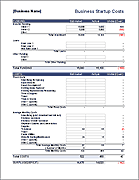
Financial Statements
- Account Log In |
- View / Sign Loan Docs |
- PartnerPortal |
- Payment Estimator
Personal Financial Statement – Creating a Business Plan

by Scott Jones | September 6, 2023

In the previous installment of this series, we went over your management and organization . Now we’ll take a look at your personal financial statement.
According to SCORE , in the simplest of terms, a personal financial statement is a snapshot of your personal financial situation at a specific point in time.
New businesses may use this statement to get the loans/financing they need to get things up and running. For existing businesses, it can be used to lease additional workspaces or access capital for new equipment or if you’re purchasing another business for further expansion.
Your comprehensive financial statement should include the following:
Personal Assets
- Your home and other properties you own, such as rentals and commercial property
- Checking and savings accounts
- Stocks and bonds
- Retirement accounts
- Life insurance accounts
- Collectibles, jewelry, art, etc.
Personal Liabilities
- Personal loans (mortgage, student, auto, etc.)
- Credit card balances
- Money owed due to judgments or liens
This section should focus on the business owner and not business assets/liabilities. That information will be included in another section. The assets of your spouse, if you have one, should be here
It’s important that you’re as transparent as possible here. Providing false information is a violation of federal law and could result in fines and criminal prosecution.
In the next installment of this series, we’ll look at the financial history and analysis portion of your business plan.
Blog Archives
No posts for Apr , 2024
Recent Posts
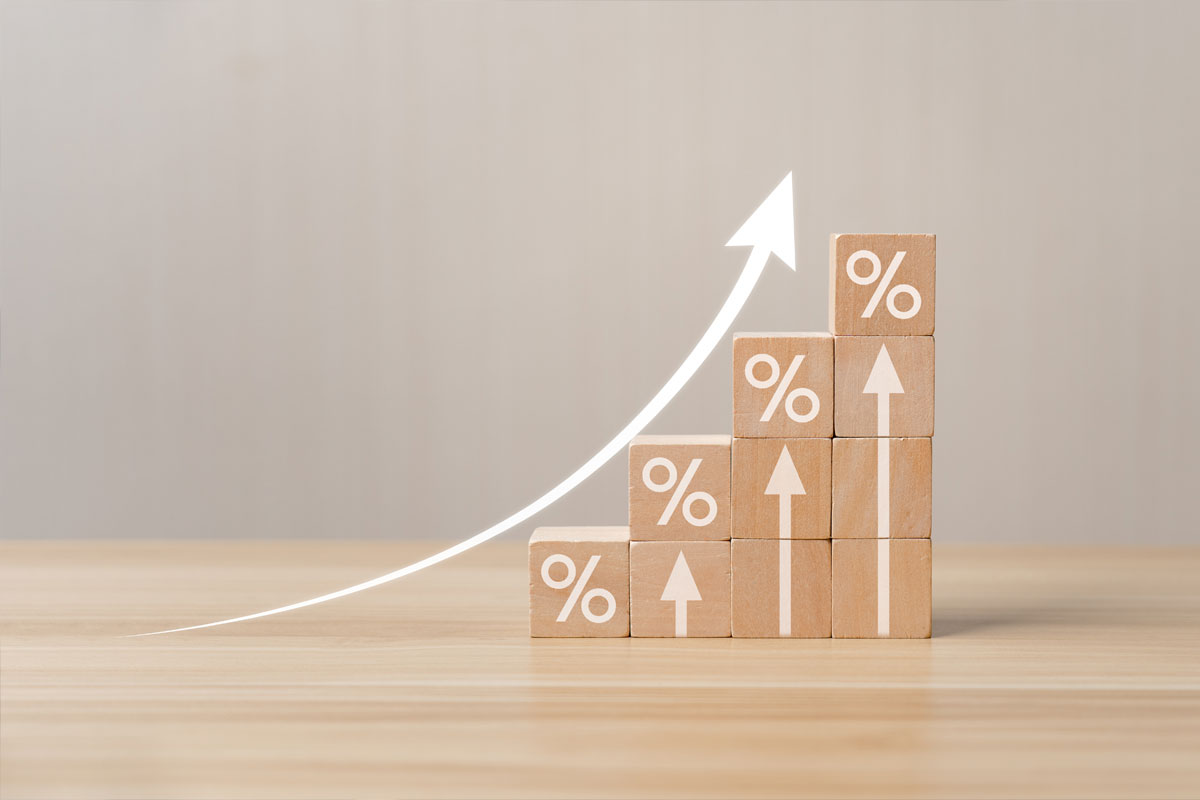
Everything you need to know about interest rates

Using Your Brand to Grow Your Business
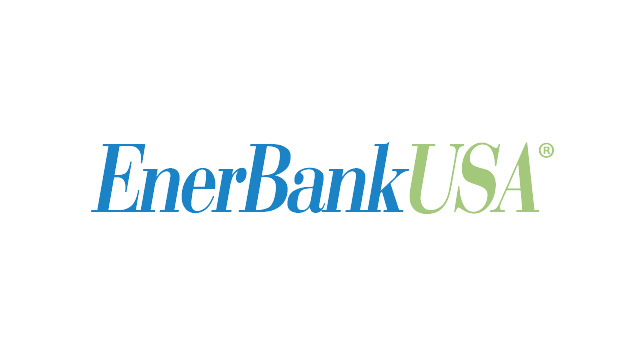
What you need to know about interest rates
Scott jones.
Scott Jones is Vice President, Senior Relationship Manager at Regions | EnerBank. For over ten years, he's focused on helping home improvement contractors sell more projects and make more money. He's worked with hundreds of contractors of various sizes, from $500,000 to $150 million in annual revenue. Before joining EnerBank, Scott spent several years in management roles, including with Pella Windows.

Selling Unafraid — Why Should People Hire You?
The expectations vs. realities of contractor financing.

- 400+ Sample Business Plans
- WHY UPMETRICS?
Customer Success Stories
Business Plan Course
Strategic Planning Templates
E-books, Guides & More
Entrepreneurs & Small Business
Accelerators & Incubators
Business Consultants & Advisors
Educators & Business Schools
Students & Scholars
AI Business Plan Generator
Financial Forecasting
AI Assistance
Ai Pitch Deck Generator
Strategic Planning
See How Upmetrics Works →
- Sample Plans
Small Business Tools
How to Prepare a Financial Plan for Startup Business (w/ example)

Free Financial Statements Template
Ajay Jagtap
- December 7, 2023
13 Min Read

If someone were to ask you about your business financials, could you give them a detailed answer?
Let’s say they ask—how do you allocate your operating expenses? What is your cash flow situation like? What is your exit strategy? And a series of similar other questions.
Instead of mumbling what to answer or shooting in the dark, as a founder, you must prepare yourself to answer this line of questioning—and creating a financial plan for your startup is the best way to do it.
A business plan’s financial plan section is no easy task—we get that.
But, you know what—this in-depth guide and financial plan example can make forecasting as simple as counting on your fingertips.
Ready to get started? Let’s begin by discussing startup financial planning.
What is Startup Financial Planning?
Startup financial planning, in simple terms, is a process of planning the financial aspects of a new business. It’s an integral part of a business plan and comprises its three major components: balance sheet, income statement, and cash-flow statement.
Apart from these statements, your financial section may also include revenue and sales forecasts, assets & liabilities, break-even analysis , and more. Your first financial plan may not be very detailed, but you can tweak and update it as your company grows.
Key Takeaways
- Realistic assumptions, thorough research, and a clear understanding of the market are the key to reliable financial projections.
- Cash flow projection, balance sheet, and income statement are three major components of a financial plan.
- Preparing a financial plan is easier and faster when you use a financial planning tool.
- Exploring “what-if” scenarios is an ideal method to understand the potential risks and opportunities involved in the business operations.
Why is Financial Planning Important to Your Startup?
Poor financial planning is one of the biggest reasons why most startups fail. In fact, a recent CNBC study reported that running out of cash was the reason behind 44% of startup failures in 2022.
A well-prepared financial plan provides a clear financial direction for your business, helps you set realistic financial objectives, create accurate forecasts, and shows your business is committed to its financial objectives.
It’s a key element of your business plan for winning potential investors. In fact, YC considered recent financial statements and projections to be critical elements of their Series A due diligence checklist .
Your financial plan demonstrates how your business manages expenses and generates revenue and helps them understand where your business stands today and in 5 years.
Makes sense why financial planning is important to your startup, doesn’t it? Let’s cut to the chase and discuss the key components of a startup’s financial plan.
Say goodbye to old-school excel sheets & templates
Make accurate financial plan faster with AI
Plans starting from $7/month

Key Components of a Startup Financial Plan
Whether creating a financial plan from scratch for a business venture or just modifying it for an existing one, here are the key components to consider including in your startup’s financial planning process.
Income Statement
An Income statement , also known as a profit-and-loss statement(P&L), shows your company’s income and expenditures. It also demonstrates how your business experienced any profit or loss over a given time.
Consider it as a snapshot of your business that shows the feasibility of your business idea. An income statement can be generated considering three scenarios: worst, expected, and best.
Your income or P&L statement must list the following:
- Cost of goods or cost of sale
- Gross margin
- Operating expenses
- Revenue streams
- EBITDA (Earnings before interest, tax, depreciation , & amortization )
Established businesses can prepare annual income statements, whereas new businesses and startups should consider preparing monthly statements.
Cash flow Statement
A cash flow statement is one of the most critical financial statements for startups that summarize your business’s cash in-and-out flows over a given time.
This section provides details on the cash position of your business and its ability to meet monetary commitments on a timely basis.
Your cash flow projection consists of the following three components:
✅ Cash revenue projection: Here, you must enter each month’s estimated or expected sales figures.
✅ Cash disbursements: List expenditures that you expect to pay in cash for each month over one year.
✅ Cash flow reconciliation: Cash flow reconciliation is a process used to ensure the accuracy of cash flow projections. The adjusted amount is the cash flow balance carried over to the next month.
Furthermore, a company’s cash flow projections can be crucial while assessing liquidity, its ability to generate positive cash flows and pay off debts, and invest in growth initiatives.
Balance Sheet
Your balance sheet is a financial statement that reports your company’s assets, liabilities, and shareholder equity at a given time.
Consider it as a snapshot of what your business owns and owes, as well as the amount invested by the shareholders.
This statement consists of three parts: assets , liabilities, and the balance calculated by the difference between the first two. The final numbers on this sheet reflect the business owner’s equity or value.
Balance sheets follow the following accounting equation with assets on one side and liabilities plus Owner’s equity on the other:
Here is what’s the core purpose of having a balance-sheet:
- Indicates the capital need of the business
- It helps to identify the allocation of resources
- It calculates the requirement of seed money you put up, and
- How much finance is required?
Since it helps investors understand the condition of your business on a given date, it’s a financial statement you can’t miss out on.
Break-even Analysis
Break-even analysis is a startup or small business accounting practice used to determine when a company, product, or service will become profitable.
For instance, a break-even analysis could help you understand how many candles you need to sell to cover your warehousing and manufacturing costs and start making profits.
Remember, anything you sell beyond the break-even point will result in profit.
You must be aware of your fixed and variable costs to accurately determine your startup’s break-even point.
- Fixed costs: fixed expenses that stay the same no matter what.
- Variable costs: expenses that fluctuate over time depending on production or sales.
A break-even point helps you smartly price your goods or services, cover fixed costs, catch missing expenses, and set sales targets while helping investors gain confidence in your business. No brainer—why it’s a key component of your startup’s financial plan.
Having covered all the key elements of a financial plan, let’s discuss how you can create a financial plan for your startup.
How to Create a Financial Section of a Startup Business Plan?
1. determine your financial needs.
You can’t start financial planning without understanding your financial requirements, can you? Get your notepad or simply open a notion doc; it’s time for some critical thinking.
Start by assessing your current situation by—calculating your income, expenses , assets, and liabilities, what the startup costs are, how much you have against them, and how much financing you need.
Assessing your current financial situation and health will help determine how much capital you need for your startup and help plan fundraising activities and outreach.
Furthermore, determining financial needs helps prioritize operational activities and expenses, effectively allocate resources, and increase the viability and sustainability of a business in the long run.
Having learned to determine financial needs, let’s head straight to setting financial goals.
2. Define Your Financial Goals
Setting realistic financial goals is fundamental in preparing an effective financial plan. So, it would help to outline your long-term strategies and goals at the beginning of your financial planning process.
Let’s understand it this way—if you are a SaaS startup pursuing VC financing rounds, you may ask investors about what matters to them the most and prepare your financial plan accordingly.
However, a coffee shop owner seeking a business loan may need to create a plan that appeals to banks, not investors. At the same time, an internal financial plan designed to offer financial direction and resource allocation may not be the same as previous examples, seeing its different use case.
Feeling overwhelmed? Just define your financial goals—you’ll be fine.
You can start by identifying your business KPIs (key performance indicators); it would be an ideal starting point.
3. Choose the Right Financial Planning Tool
Let’s face it—preparing a financial plan using Excel is no joke. One would only use this method if they had all the time in the world.
Having the right financial planning software will simplify and speed up the process and guide you through creating accurate financial forecasts.
Many financial planning software and tools claim to be the ideal solution, but it’s you who will identify and choose a tool that is best for your financial planning needs.

Create a Financial Plan with Upmetrics in no time
Enter your Financial Assumptions, and we’ll calculate your monthly/quarterly and yearly financial projections.

Start Forecasting
4. Make Assumptions Before Projecting Financials
Once you have a financial planning tool, you can move forward to the next step— making financial assumptions for your plan based on your company’s current performance and past financial records.
You’re just making predictions about your company’s financial future, so there’s no need to overthink or complicate the process.
You can gather your business’ historical financial data, market trends, and other relevant documents to help create a base for accurate financial projections.
After you have developed rough assumptions and a good understanding of your business finances, you can move forward to the next step—projecting financials.
5. Prepare Realistic Financial Projections
It’s a no-brainer—financial forecasting is the most critical yet challenging aspect of financial planning. However, it’s effortless if you’re using a financial planning software.
Upmetrics’ forecasting feature can help you project financials for up to 7 years. However, new startups usually consider planning for the next five years. Although it can be contradictory considering your financial goals and investor specifications.
Following are the two key aspects of your financial projections:
Revenue Projections
In simple terms, revenue projections help investors determine how much revenue your business plans to generate in years to come.
It generally involves conducting market research, determining pricing strategy , and cash flow analysis—which we’ve already discussed in the previous steps.
The following are the key components of an accurate revenue projection report:
- Market analysis
- Sales forecast
- Pricing strategy
- Growth assumptions
- Seasonal variations
This is a critical section for pre-revenue startups, so ensure your projections accurately align with your startup’s financial model and revenue goals.
Expense Projections
Both revenue and expense projections are correlated to each other. As revenue forecasts projected revenue assumptions, expense projections will estimate expenses associated with operating your business.
Accurately estimating your expenses will help in effective cash flow analysis and proper resource allocation.
These are the most common costs to consider while projecting expenses:
- Fixed costs
- Variable costs
- Employee costs or payroll expenses
- Operational expenses
- Marketing and advertising expenses
- Emergency fund
Remember, realistic assumptions, thorough research, and a clear understanding of your market are the key to reliable financial projections.
6. Consider “What if” Scenarios
After you project your financials, it’s time to test your assumptions with what-if analysis, also known as sensitivity analysis.
Using what-if analysis with different scenarios while projecting your financials will increase transparency and help investors better understand your startup’s future with its best, expected, and worst-case scenarios.
Exploring “what-if” scenarios is the best way to better understand the potential risks and opportunities involved in business operations. This proactive exercise will help you make strategic decisions and necessary adjustments to your financial plan.
7. Build a Visual Report
If you’ve closely followed the steps leading to this, you know how to research for financial projections, create a financial plan, and test assumptions using “what-if” scenarios.
Now, we’ll prepare visual reports to present your numbers in a visually appealing and easily digestible format.
Don’t worry—it’s no extra effort. You’ve already made a visual report while creating your financial plan and forecasting financials.
Check the dashboard to see the visual presentation of your projections and reports, and use the necessary financial data, diagrams, and graphs in the final draft of your financial plan.
Here’s what Upmetrics’ dashboard looks like:

8. Monitor and Adjust Your Financial Plan
Even though it’s not a primary step in creating a good financial plan, it’s quite essential to regularly monitor and adjust your financial plan to ensure the assumptions you made are still relevant, and you are heading in the right direction.
There are multiple ways to monitor your financial plan.
For instance, you can compare your assumptions with actual results to ensure accurate projections based on metrics like new customers acquired and acquisition costs, net profit, and gross margin.
Consider making necessary adjustments if your assumptions are not resonating with actual numbers.
Also, keep an eye on whether the changes you’ve identified are having the desired effect by monitoring their implementation.
And that was the last step in our financial planning guide. However, it’s not the end. Have a look at this financial plan example.
Startup Financial Plan Example
Having learned about financial planning, let’s quickly discuss a coffee shop startup financial plan example prepared using Upmetrics.
Important Assumptions
- The sales forecast is conservative and assumes a 5% increase in Year 2 and a 10% in Year 3.
- The analysis accounts for economic seasonality – wherein some months revenues peak (such as holidays ) and wanes in slower months.
- The analysis assumes the owner will not withdraw any salary till the 3rd year; at any time it is assumed that the owner’s withdrawal is available at his discretion.
- Sales are cash basis – nonaccrual accounting
- Moderate ramp- up in staff over the 5 years forecast
- Barista salary in the forecast is $36,000 in 2023.
- In general, most cafes have an 85% gross profit margin
- In general, most cafes have a 3% net profit margin
Projected Balance Sheet

Projected Cash-Flow Statement

Projected Profit & Loss Statement

Break Even Analysis

Start Preparing Your Financial Plan
We covered everything about financial planning in this guide, didn’t we? Although it doesn’t fulfill our objective to the fullest—we want you to finish your financial plan.
Sounds like a tough job? We have an easy way out for you—Upmetrics’ financial forecasting feature. Simply enter your financial assumptions, and let it do the rest.
So what are you waiting for? Try Upmetrics and create your financial plan in a snap.
Build your Business Plan Faster
with step-by-step Guidance & AI Assistance.

Frequently Asked Questions
How often should i update my financial projections.
Well, there is no particular rule about it. However, reviewing and updating your financial plan once a year is considered an ideal practice as it ensures that the financial aspirations you started and the projections you made are still relevant.
How do I estimate startup costs accurately?
You can estimate your startup costs by identifying and factoring various one-time, recurring, and hidden expenses. However, using a financial forecasting tool like Upmetrics will ensure accurate costs while speeding up the process.
What financial ratios should startups pay attention to?
Here’s a list of financial ratios every startup owner should keep an eye on:
- Net profit margin
- Current ratio
- Quick ratio
- Working capital
- Return on equity
- Debt-to-equity ratio
- Return on assets
- Debt-to-asset ratio
What are the 3 different scenarios in scenario analysis?
As discussed earlier, Scenario analysis is the process of ascertaining and analyzing possible events that can occur in the future. Startups or businesses often consider analyzing these three scenarios:
- base-case (expected) scenario
- Worst-case scenario
- best case scenario.
About the Author

Ajay is a SaaS writer and personal finance blogger who has been active in the space for over three years, writing about startups, business planning, budgeting, credit cards, and other topics related to personal finance. If not writing, he’s probably having a power nap. Read more
Reach Your Goals with Accurate Planning
No Risk – Cancel at Any Time – 15 Day Money Back Guarantee
Popular Templates

Please update your browser.
We don't support this browser version anymore. Using an updated version will help protect your accounts and provide a better experience.
Update your browser
We don't support this browser version anymore. Using an updated version will help protect your accounts and provide a better experience.
We’ve signed you out of your account.
You’ve successfully signed out
We’ve enhanced our platform for chase.com. For a better experience, download the Chase app for your iPhone or Android. Or, go to System Requirements from your laptop or desktop.
Credit Cards
Checking Accounts
Savings Accounts
Mortgage & Home Equity
Chase for Business
Commercial Banking
- ATM & branch
Please turn on JavaScript in your browser
It appears your web browser is not using JavaScript. Without it, some pages won't work properly. Please adjust the settings in your browser to make sure JavaScript is turned on.
Chase Survey
Your feedback is important to us. Will you take a few moments to answer some quick questions?
You're now leaving Chase
Chase's website and/or mobile terms, privacy and security policies don't apply to the site or app you're about to visit. Please review its terms, privacy and security policies to see how they apply to you. Chase isn’t responsible for (and doesn't provide) any products, services or content at this third-party site or app, except for products and services that explicitly carry the Chase name.
- Updated Terms of Use
- New Privacy Policy
- Your Privacy Choices
- Closed Captioning Policy
Quotes displayed in real-time or delayed by at least 15 minutes. Market data provided by Factset . Powered and implemented by FactSet Digital Solutions . Legal Statement .
This material may not be published, broadcast, rewritten, or redistributed. ©2024 FOX News Network, LLC. All rights reserved. FAQ - New Privacy Policy
Biden announces a fresh round of $7.5 billion in student loans canceled
Income-driven repayment plan faces legal challenges.

The Biden administration announced ]more student loans are eligible for cancellation. ( iStock )
President Joe Biden is keeping the ball rolling on student loan forgiveness, canceling a new round of loans as his administration crafts a new plan to target even more outstanding student debt.
The latest round of cancelations targets $7.4 billion in student loans for 277,000 borrowers, the Department of Education said in a statement . This brings the total debt forgiven over Biden's presidency to $153 billion. The discharges are part of the Saving on a Valuable Education (SAVE) Plan, which offers a faster route to forgiveness.
"Today we are helping 277,000 borrowers who have been making payments on their student loans for at least a decade," U.S. Under Secretary of Education James Kvaal said. "They have paid what they can afford, and they have earned loan forgiveness for the balance of their loan."
More people are becoming eligible for student loan cancelation as they hit 10 years of payments. Since the launch of SAVE, nearly 8 million borrowers have received relief, including 4.5 million with a $0 monthly payment. Student loan forgiveness has reached millions even as the Supreme Court blocked Biden's original debt forgiveness plan last June.
The Biden Administration has also released initial details of a new set of plans that would provide student debt relief to over 30 million borrowers, including the 4 million who have already been approved for debt cancelation over the past three years. The new plan also proposes to eliminate accrued interest for 23 million borrowers and automatically discharge debt for borrowers eligible for loan forgiveness under SAVE, closed school discharge, or other forgiveness programs, even if not enrolled. Additionally, student debt for borrowers who entered repayment for 20 or more years would be discharged.
Private student loan borrowers can't benefit from federal loan relief. But you could lower your monthly payments by refinancing to a lower interest rate. Visit Credible to speak with an expert and get your questions answered.
BUY A HOME IN THESE STATES TO GET STUDENT LOAN DEBT RELIEF
Some borrowers miss out on SAVE
Biden's SAVE plan could lower borrowers' monthly payments to zero dollars, reduce monthly costs in half and save those who make payments at least $1,000 yearly. Yet roughly three out of four borrowers who make $75,000 or less annually and would benefit from the SAVE plan still need to be enrolled, according to a recent Student Debt Crisis Center (SDCC) survey .
Part of the problem is the lack of communication between student loan servicers and borrowers, according to the survey. Every student loan borrower is assigned a loan servicer to help them navigate repayment options, including income-driven repayment (IDR), which can make payments more affordable.
More than half of borrowers who contacted their student loan servicers with questions about resuming payments were left with unanswered questions. Moreover, a quarter of borrowers don't trust the information they get from their servicer, and 75% said the information they got was inaccurate or incomplete.
"As a student loan borrower myself, I know firsthand how frustrating and harmful these communication errors can be, "SDCC Managing Director Sabrina Calazans said. " Borrowers need more communications coming directly from the Department of Education, given their lack of trust in their respective service providers."
If you're having trouble making payments on your private student loans, you won't benefit from federal relief. You could consider refinancing your loans for a lower interest rate to lower your monthly payments. Visit Credible to get your personalized rate in minutes without affecting your credit score.
HOMEOWNERS COULD SAVE TENS OF THOUSANDS IN DAMAGES BY USING SMART DEVICES
Legal challenges to student loan forgiveness mount
Republican-led states filed suit against President Joe Biden and the U.S. Department of Education to stop the SAVE Plan.
The lawsuit seeks to halt the SAVE plan immediately, arguing that the U.S. Department of Education has no authority to alter student loan repayment plans. This would essentially cancel more than $156 billion in student loan debt. The attorneys general from Alabama, Alaska, Idaho, Iowa, Louisiana, Montana, Nebraska, South Carolina, Texas and Utah joined the suit.
The lawsuit also argues that the U.S. Supreme Court ruled that Biden's original forgiveness program violated federal law and that only Congress can authorize the forgiveness of student loans, which requires spending taxpayer money.
A statement from the Education Department said Congress gave the agency the authority to define the terms of income-driven repayment plans.
If you hold private student loans, you won't be enrolled in a federal income-driven repayment plan, but you could refinance your loans to a lower rate. Visit Credible to compare options from different lenders without affecting your credit score.
MORTGAGE LOAN LIMIT RISES ABOVE $1.1M AS HOME PRICES SURGE
Have a finance-related question, but don't know who to ask? Email The Credible Money Expert at [email protected] and your question might be answered by Credible in our Money Expert column.
As a financial planner, I give my clients 4 tips to make their money last a lifetime
Paid non-client promotion: Affiliate links for the products on this page are from partners that compensate us (see our advertiser disclosure with our list of partners for more details). However, our opinions are our own. See how we rate investing products to write unbiased product reviews.
- I'm a financial planner, and I remind clients to look at a long timespan and plan for the worst.
- There's no easy answer to earning more money, but it's important to not ignore that factor.
- I encourage my clients to focus less on frugality and more on how they'll invest in the future.

As a certified financial planner , my goal is to help self-made professionals build wealth that they can enjoy throughout their lives. To do that, we have to make sure their money will last throughout their lifetimes.
But we also need to make sure that clients actually have opportunities to use their money now while they're young, healthy, and able to fully experience life.
Here's the process we use to build long-term financial plans that work, including what your investment strategy should consider and why living frugally is a poor strategy for getting rich.
1. Plan for change
Your goals for retirement planning will probably evolve over time. The person you are today will not be the same person who retires in 10, 20, or 30 years.
A long-term financial plan that works accounts for inevitable shifts in goals, values, priorities, and circumstances. Although you might not know exactly what will change, you can still plan for an evolving life.
First, save more than you think you need to when you can. If you find you have excess cash flow, don't default to spending it or upgrading your lifestyle. Direct that money to investments instead so you can grow wealth.
Avoid unrealistic assumptions about future income and expenses. For my own planning, I assume a lower-than-expected growth in income and a higher-than-expected run rate for my cost of living.
When making decisions, opt for choices that allow you to walk away at a low cost. This makes it possible to change or adjust course as needed. Be cautious about decisions that demand fixed commitments (like buying a house) that are difficult to reverse.
2. Look for ways to earn more
Personally, I've shifted from "retire as soon as possible" to a more balanced approach to my financial goals.
I save less money now because I want to use some of my income for important experiences throughout life. I don't want to save everything for use on a distant (and unreliable!) "someday" in the future.
My financial plan can accommodate this choice for two main reasons:
First, I saved aggressively when I could for almost a decade. I've saved at least 30% to 40% of my income . The fact I did so in the past gives me increased flexibility now.
I also put a lot of time and energy into earning more money through growing my business.
If you want to grow wealth, increasing your income will fast-track your efforts. Too many people who want to throw out money tips ignore this reality.
I understand why no one wants to talk about it. Earning more is not easy to do, and there's no one piece of prescriptive advice to give that will help everyone.
But we cannot ignore the importance of making more money if our goal is to create more wealth. There are many avenues that can get you to a higher income, so you don't need one right answer. You need to select and stick with a strategy that makes sense for you.
3. Remember, frugality will only get you so far
No matter what you want to do, you'll need money to afford your chosen lifestyle in the future. And you won't be able to work to earn an income forever. By choice or by circumstance, you will eventually need another way to pay for your needs other than your own work.
This means we must recognize the necessity of saving money and investing . There's no disputing that. The question is how .
Living frugally to get wealthy is possible; it's a simple fact that the lower your expenses are, the more you can save.
But it's an inefficient path to building wealth. There are only so many costs you can cut. And only saving money misses out on opportunities to create assets that increase in value over time.
4. Develop an investment strategy
If you want to grow wealth without pinching pennies, you have to invest — and you have to do that wisely.
A sound investment strategy needs to consider:
- What investment vehicles to use
- The right asset allocation based on your goals and your time horizons
- The expenses associated with your chosen investments and how that may impact your returns
- How to leverage diversification across your portfolio as well as across the specific brokerage accounts or assets you invest into
- The tax implications of your choices
- Mistakes to avoid, including speculating, market timing, and taking on too much (or the wrong type) of risk
That just scratches the surface of comprehensive investment management here. But in general, if you want to build an investment strategy that will help you grow wealth, you want to look for:
- Long-term time horizons : The longer your money can be invested, the better your odds of a successful outcome where you see growth of your assets.
- Risk-adjusted strategies : You want to take on enough risk to see a return, but not more than you can actually afford to realize (or more than you need to meet your goals).
- Globally diversified portfolios : Remember that there is a literal world of financial markets out there. Throwing your money into one to three index funds that are all US large-cap stocks or US bonds is not a good example of true diversification.
One final key to keep in mind: You're better off sticking with a decent strategy that works over time than constantly hopping from one thing to another in search of the best strategy ever. Consistency is an underrated element on the road to building wealth.
Watch: 6 simple investing tips for beginners
- Main content

IMAGES
VIDEO
COMMENTS
What to Include in a Personal Financial Statement. As previously mentioned, there are two core sections of any PFS. Here's how each section can be defined: Balance sheet: Your balance sheet will include all your assets and liabilities. This may include your home, mortgage, car, auto loan, taxes, savings accounts, investment accounts, credit ...
Personal Financial Statement: A document or spreadsheet outlining an individual's financial position at a given point in time. A personal financial statement will typically include general ...
Financial Statements You Will Need. A startup budget or cash flow statement. A startup costs worksheet. A pro forma (projected) profit and loss statement. A pro forma (projected) balance sheet. Sources and uses of funds statement. Break-even analysis.
A personal financial statement (PFS) is a snapshot of your financial position at a specific time. It lists your assets (what you own), liabilities (what you owe), and net worth. A PFS is essential for entrepreneurs looking to buy a business, get a loan, rent an office or storefront and more.
A personal financial statement is a document, or set of documents, that outlines an individual's financial position at a given point in time. It is usually composed of two sections - a balance sheet section and an income flow section. Although an individual can use more complex personal financial statements, this article will focus on a ...
A personal cash flow statement measures your cash inflows and outflows to show you your net cash flow for a specific period. Cash inflows generally include: Salaries. Interest from savings ...
What Is a Personal Financial Statement? Definition and Examples of a Personal Financial Statement. By Jean Murray. Updated on June 30, 2020. Photo: Anchiy / Getty Images. A personal financial statement is a key document when applying for a business loan. Review tips on what to include and how to put the statement together.
A personal financial statement is a document that lists all your assets, liabilities, and resulting net worth. Personal financial statements can be used by individuals and businesses. A personal financial statement is important because it shows you if you're building wealth, and can play a critical role in helping you get approved for loans.
A personal financial statement is a form or spreadsheet detailing a person's financial state at a certain point in time. It may be requested by financial institutions or investors if you're looking to take out a loan or secure an investment. ... Business Plan: A business plan is a document that defines the financial aspirations and obligations ...
A personal financial statement is a report or set of documents that summarizes an individual's financial situation at a particular time. It is often divided into two sections: the balance sheet and the income statement. The balance sheet provides a breakdown of assets and liabilities, while the income statement summarizes income and expenses.
Way #4 - Invest in yourself. There are a lot of things you can do to invest in yourself, but one of the smartest things you can do is to invest in your personal finance education. In fact, one of the popular millionaire quotes from Warren Buffet is: Invest in yourself as much as possible. Warren Buffet.
This personal financial statement template is a great tool to keep track your personal assets, liabilities, income and expenses. A personal financial statement is a document or set of documents that outline an individual's financial position at a given point in time. It is usually composed of two sections: a balance sh.
Personal financial statements, which comprise a balance sheet and cash flow statement, provide a snapshot of your financial health, allowing you to evaluate your current financial condition, track changes over time, and plan for the future. ... Business Income: If you have a side business or gig, such as freelance work or a small online ...
A personal financial statement can also be a great tool when you're ready to apply for a loan or mortgage. First, list all of your assets which include (but aren't limited to): Your cash: The total balance of your checking accounts, savings accounts and any cash on hand. Your retirement accounts: Include your 401k and your IRA, if you have ...
Use the numbers that you put in your sales forecast, expense projections, and cash flow statement. "Sales, lest cost of sales, is gross margin," Berry says. "Gross margin, less expenses, interest ...
A personal financial statement is a spreadsheet that details the assets and liabilities of an individual, couple, or business at a specific point in time. Typically, the spreadsheet consists of two columns, with assets listed on the left and liabilities on the right.
This financial plan projections template comes as a set of pro forma templates designed to help startups. The template set includes a 12-month profit and loss statement, a balance sheet, and a cash flow statement for you to detail the current and projected financial position of a business. . Download Startup Financial Projections Template.
Create Document. Updated October 11, 2023. A personal financial statement is a document summarizing a person's financial standing. It provides a full list of their personal assets and liabilities as well as their income and expenses. Commonly required by financial institutions when applying for credit or a loan, it demonstrates a person's ...
Creating and maintaining your own Personal Financial Statement is useful for 4 main purposes: (1) Gaining a good financial education, (2) Creating and evaluating your budget, (3) Applying for business loans, and (4) Applying for personal loans.. If you already know why you need one, and why you want to use Excel to create one, then go ahead and download the template below.
Below is an example of a basic personal financial statement, which provides a snapshot of your finances at the particular time you prepare the statement. For more information and resources related to this topic, you can visit FindLaw's Startup Financing section. Assets. Cash $__________.
In the previous installment of this series, we went over your management and organization.Now we'll take a look at your personal financial statement. According to SCORE, in the simplest of terms, a personal financial statement is a snapshot of your personal financial situation at a specific point in time.. New businesses may use this statement to get the loans/financing they need to get ...
Revenue - Expenses = Profit / Loss. Consider it as a snapshot of your business that shows the feasibility of your business idea. An income statement can be generated considering three scenarios: worst, expected, and best. Your income or P&L statement must list the following: Cost of goods or cost of sale.
Three financial statements --a balance sheet, income statement, and cash-flow statement -- are required for any financial projections you create. New businesses need financial projections, too.
J.P. Morgan Wealth Management is a business of JPMorgan Chase & Co., which offers investment products and services through J.P. Morgan Securities LLC (JPMS), a registered broker-dealer and investment adviser, member FINRA and SIPC.Insurance products are made available through Chase Insurance Agency, Inc. (CIA), a licensed insurance agency, doing business as Chase Insurance Agency Services, Inc ...
The latest round of cancelations targets $7.4 billion in student loans for 277,000 borrowers, the Department of Education said in a statement.This brings the total debt forgiven over Biden's ...
Here's the process we use to build long-term financial plans that work, including what your investment strategy should consider and why living frugally is a poor strategy for getting rich. 1. Plan ...